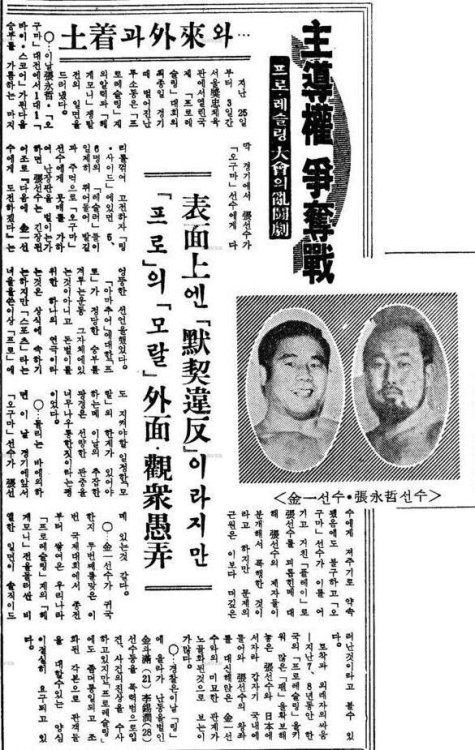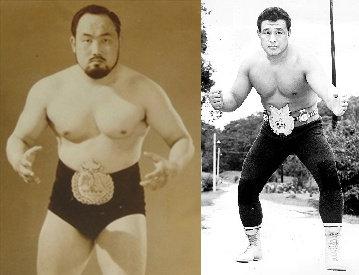-
Posts
422 -
Joined
-
Last visited
Content Type
Profiles
Forums
Blogs
Everything posted by KinchStalker
-
Junzo Yoshinosato (芳の里淳三) Profession: Wrestler, Executive, Commentator (Color) Real name: Junzo Hasegawa (長谷川淳三) Professional names: Junzo Yoshinosato, Yoshino Sato Life: 9/27/1928-1/19/1999 Born: Ichinomiya, Chiba, Japan Career: 1954-1973 Height/Weight: 174cm/84kg (5’9”/185lbs.) Signature moves: Small package Promotions: Japan Wrestling Association, International Wrestling Enterprise (as commentator) Titles: Japanese Light Heavyweight [JWA] (1x), Japanese Junior Heavyweight [JWA] (1x) Junzo Hasegawa, or Yoshinosato, carved out a niche as one of puroresu’s earliest junior heavyweights, but for better or worse, his legacy is defined by his career as a JWA executive and its last president. Yoshinosato during his sumo career. The fourth son of a farmer-fisherman, Junzo Hasegawa was an athletic child. He aspired to enter sumo, and did so despite his small size by getting in through wrestler Kamikaze Shoichi. Hasegawa joined the Nishonoseki stable, for which he debuted under his family name in January 1944. As this was the twilight of the Pacific War, Hasegawa was among a group of fellow Nishonoseki wrestlers, led by their master Tamanoumi, who worked hard labor for food in an Amagasaki munitions factory. (Tamanoumi would be charged as a war criminal for this, and his reputation with the Japan Sumo Association never recovered.) When the Great Tokyo Air Raid reduced Nishonoseki’s headquarters to rubble, the stable rented a room at the Shinmonji Temple, where they remained until 1950. Hasegawa devoted himself to training, and in 1947, he received his first shikona: Kamiwaka, derived from the rikishi who he had idolized in his youth. Despite his frame, Junzo became noted for his technical skill and a particular prowess at the beltless underarm throw known as sukuinage. In 1949, as the sumo schedule returned to three tournaments, Kamiwaka was promoted to the second-highest division, juryo. Another promotion to makushita followed at the start of the decade, but he struggled and was demoted in 1951. It was after this knock down back to juryo that he debuted the shikona that would stick: Yoshinosato Yasuhide. Yoshinosato was not among those that started puroresu, but he made an early career change. Junzo had become disillusioned with Nishonoseki and its turmoil. His beloved Kamikaze was retiring to become a sumo commentator. Tamanoumi had passed the stable down to Saganohana in 1952, and his policy of encouraging his makuuchi to take on disciples had led to the departures of Ōnoumi and future yokozuna Wakanohana. Despite all of this, Yoshinosato was held down in juryo. Despite notching one of the strongest showings of his career in the spring 1954 tournament, where he went 11-4, he retired afterwards. Noburo Ichikawa, the victim of puroresu’s first documented shoot incident. Yoshinosato went to his former senior and join the JWA. Depending on the version of the story, he either had one day of training before his debut, which was against Teizo Watanabe on September 10 in Osaka, or first met Rikidozan at the show and had been booked on the spot. Either way, it is the fastest turnaround time in puroresu history. Three months later, he worked on the December 22, 1954 show at the Kuramae Kokugikan. This show is well known for the main event, in which Rikidozan shot on Masahiko Kimura. Far less known, at least in the West, is that it wasn’t the only shoot incident on the card, or even the most upsetting. At what the Toshiyo Masuda serial Why Didn’t Masahiko Kimura Kill Rikidozan? alleges was his boss’s order, Yoshinosato beat Noburo Ichikawa, a 38-year-old judoka who had joined Toshio Yamaguchi’s All Japan Pro Wrestling Association, into unconsciousness with “several dozen” strikes. Masuda’s serial claims that Ichikawa suffered neurological damage from this assault and died in 1967. In October 1956, Yoshinosato entered the light heavyweight bracket of the interpromotional Japanese Weight Division Championship tournaments, which were a means for Rikidozan to delegitimize his regional competition and scout talent worth poaching from them. After wins against Toa Pro Wrestling’s Genji Umehara, fellow JWA member Toshikazu Higa, and Asia Pro Wrestling’s Kiyotaka Otsubo, Yoshinosato faced his coworker Isao Yoshiwara to crown the first Japanese light heavyweight champion. At the Ryogoku International Stadium on October 23, Junzo won two straight falls, first with an abdominal stretch and then with an armbar. On November 30, Yoshinosato wrestled a champion vs champion match against junior heavyweight champ Surugaumi, which went to a draw. While Surugaumi’s title reign ended to Michiaki Yoshimura the following year, Yoshinosato held onto his belt for the rest of the decade. Like the junior title, which was also only contended between native talent, the light heavyweight belt was essentially abandoned after the turbulence of the late fifties showed that the JWA could not draw with anything but Rikidozan versus foreigners. In November 1958, Yoshinosato accompanied Rikidozan on his first trip to Brazil, working shows with him for a month as JWA shows drew all-time lows without their ace. By the summer of 1960, though, Yoshimura was ready for a promotion to the heavyweight division. Yoshinosato challenged him for the junior title, and a match was booked for the Taito Ward Gymnasium on August 19. While three hours of Yoshimura footage circulates on tape, little of Yoshinosato’s work is known to survive. This means that our only knowledge of his style in the ring comes from written coverage of the time. Fortunately, the Showa Puroresu zine reproduces an evocative report of this match from Pro Wrestling & Boxing magazine. It describes the 61-minute draw, which was officiated by none other than Rikidozan, as a lively, then grueling affair. The smaller Yoshinosato is described as a scrappy, unscrupulous challenger. The title did not properly change hands, but with Yoshimura’s promotion, Yoshinosato was awarded the junior title by default. His light heavyweight title was won by Isao Yoshiwara in a subsequent tournament. Yoshinosato left for the United States alongside Shohei Baba and Yukio Suzuki in June 1961. Although he worked for NWA Hollywood and in the Northeast like them, his two years abroad were most notable for a stint as a stock Japanese heel, Yoshino Sato, alongside Tojo Yamamoto in Tennessee. This would influence him when he returned home, as he took to wearing “rice-field” tights while using his geta (wooden sandals) as a weapon. He returned in September 1963, just months before Rikidozan's death. When that came on December 15, he got a promotion. Yoshinosato was one of the four wrestlers rapidly promoted to an executive position, alongside Toyonobori, Kokichi Endo, and Yoshimura. At first, they were named directors, while widow Keiko Momota assumed a figurehead position as company president. Yoshinosato, Toyonobori, Endo, and Yoshimura in a famous photoshoot after Rikidozan’s death. This was a deeply turbulent period in puroresu, as just five months after Rikidozan’s death, the death of commissioner Bamboku Ono dealt almost as severe a blow as that had. Without the flagrantly yakuza-tainted politician to act as a buffer against law enforcement, the Tokyo Metropolitan Police set their sights on the JWA as part of the first Operation Summit. The top shareholders were ultranationalist fixer Yoshio Kodama and top yakuza godfathers Kazuo Taoka and Hisayuki Machii. Not only did they step down in 1965, as Keiko and managing director Hiroshi Iwata did the same, but the JWA was also forced to cut ties with all but seven of the local promoters they sold shows to. Toyonobori was promoted to president, with Yoshinosato as his VP. Junzo was forced to pick up his slack, as Toyonobori was less interested in doing his job than in betting on horses with the company safe as his piggy bank. Yoshinosato continued to wrestle in this period; in fact, footage from a May 1964 tag match broadcast on G+’s 2019 JWA program, as seen in this screencap, is the only surviving tape of him that I am aware of. (Unfortunately, I have not found a copy of this as of writing.) In August 1965, he wrestled his last significant matches abroad. Kim Il, or Kintaro Oki, held his first South Korean tour with the support of the JWA and the resentful cooperation of native wrestler-promoter Jang Yeong-chol. Kim defeated Yoshinosato in the final match of an eight-man tournament to be crowned the first Far East Heavyweight champion. Hasegawa and Endo with Sam Muchnick in August 1967. As the year came to a close, Toyonobori fell out of favor with his fellow executives and left. When this was publicly acknowledged in early 1966, Yoshinosato was named the new JWA president. While he received the nickname Geta President, he wouldn’t be attacking people with his sandals much longer, as Hasegawa scaled back his appearances until wrestling a final match on August 1, 1967. The first year of his presidency saw the emergence of two competitors, Toyonobori’s Tokyo Pro and Yoshiwara’s Kokusai (IWE). By the time of his last match, though, Tokyo Pro had fallen apart and Antonio Inoki had returned to the JWA. Hasegawa steered the company during its second golden age. In the year to come, Baba and Inoki begin their run as Japan’s most iconic tag team, while the JWA went to war against Kokusai. The competition led the company’s Nippon Television program to be upgraded from biweekly to weekly, with the extra broadcast money in tow. They went even beyond that in 1969, when Endo successfully maneuvered his way into getting a second network deal with NET TV. Unfortunately, this momentum was enough to sustain the good times forever. Suspicions of embezzlement accumulated as the seventies began, on top of a generally arrogant attitude towards the public and press and a lack of research on the foreigners they invited. (In a particularly notorious instance, the second NWA Tag Team League tournament lost a top gaikokujin halfway through the tour, as Cowboy Frankie Laine—the only returning entrant from the previous year—was deported for sexual assault.) As Hasegawa himself admitted later, he had never received the education to properly run a business at this scale and had worked most effectively in middle management. While he can absolutely be criticized for his incompetence, modern testimonies have suggested that subsequent depictions of his corruption and character were somewhat distorted. (One example was Mystery of the Orient: Kabuki, the final serial in Ikki Kajiwara’s Pro Wrestling Superstar Retsuden manga, which depicted Hasegawa taking money from the safe, as Toyonobori had, to drink in Ginza.) Whatever the case, the years of mismanagement culminated in the “phantom coup” of late 1971. While the most corrupt of the executive troika, Kokichi Endo, was successfully pressured to resign from his executive position, the managerial reforms fizzled out after Inoki and auditor Akimasa Kimura’s subsequent attempt to surreptitiously promote themselves to the top of the company. It was this final era of the JWA that set Hasegawa’s legacy as a once successful, but ultimately incompetent and doomed promoter. With Inoki's dismissal, NET heavily pressured the company to allow them to broadcast Baba matches and restore their ratings. Baba was contractually exclusive to NTV and personally loyal to them, but Hasegawa decided to disregard that and force Baba to work on World Pro Wrestling. This led the company to lose both NTV program Mitsubishi Diamond Hour and Baba himself, as NTV sent feelers to Baba to head a new promotion, and Baba left the JWA that summer. The JWA lasted until the spring of 1973, held afloat by the NET deal that lasted through the end of the fiscal year, before it held a small set of shows afterward with personal funds. In its final months, Hasegawa again showed his failure as an executive. In the last months of 1972, NET arranged a deal where Inoki’s independent, debt-ridden New Japan Pro-Wrestling would merge with the JWA in April 1973. This could have saved the company, and it was put in motion as Inoki and Sakaguchi held a press conference in February. However, most had not signed contracts to NET when Oki came back from Korea and rallied most of the company to refuse this merger. Where a truly capable leader would have done whatever was necessary to make this deal go through, Hasegawa just went with Oki and sealed his legacy forever. That spring, Hasegawa worked out a deal through Keiko Momota, now a director of All Japan Pro Wrestling, to have his remaining talent merge with the company. In Oki’s words, they were coming back to Rikidozan. Hasegawa (front, center) at the press conference where the JWA announced its death by AJPW merger. The man once known as Yoshinosato spent several more years involved in the business in some capacity. He was allowed to retain his membership on the NWA board as a condition of the AJPW merger. While he voted against New Japan’s membership in 1973 and 1974, he worked with the company for some months afterward, lending credibility to Inoki’s strategy to market himself as the best in Japan and blow smoke over a Baba match that would never happen. According to Shigeo Kado, Hasegawa had planned to loan the JWA’s World Big League trophy to New Japan for the 2nd World League tournament in 1975. However, as Kado claimed, he fell out with the company that spring when he was offended that they sent an executive, and not Inoki himself, to his house to discuss the matter. He instead lent the trophy to AJPW for their Open League tournament that December. In March 1976, All Japan leveraged his credibility by having him tag along on the South Korean show where the All Asia Tag Team titles were revived. He served as a color commentator on second IWE program International Pro Wrestling Hour and can be heard calling Mighty Inoue's IWA title victory against Billy Graham in October 1974. Yoshinosato served as the guest referee for the famous March 28, 1976 match between Jumbo Tsuruta and Rusher Kimura. Two years later, he refereed the February 1978 match between Baba and Kimura, with his dubious officiating blamed for one of the most humiliating finishes in the history of puroresu. (In fact, it is quite likely that Yoshinosato had suggested that finish himself, as it had been used five years earlier in one of the JWA's final main events.) I do not know much about what Hasegawa was up to after this point, until the last years of his life. In 1996, the Rikidozan OB alumni association was formed, and he was named its chairman. According to Dave Meltzer’s obituary, the final show Hasegawa promoted was a benefit for the now-paraplegic Umanosuke Ueda. After suffering a stroke in March 1998, Hasegawa died in Yokohama of cardiac arrest on January 19, 1999.
-
Yusuf Turk (ユセフ・トルコ) Profession: Wrestler, Referee, Executive Real name: Yusuf Omar Professional names: Killer Mike Yusuf, Yusuf Turk Life: 5/23/1931-10/18/2013 Born: Toyohara (now Yuzhno-Sakhalinsk), Sakhalin Career: 1954-1973 Height/Weight: 173cm/90kg (5’8”/198lbs.) Signature moves: surfboard stretch, flying knee drop Promotions: Japan Wrestling Association, New Japan Pro-Wrestling Titles: none One of puroresu’s earliest comic wrestlers and then a referee and booker, Yusuf Turk was an important figure in the ascension of Antonio Inoki, even if his relationship with the promotion he helped found was a turbulent one. The half-Japanese son of a Turkish trader, Yusuf Omar was born in Toyohara, then the capital of the southern, Japanese-held half of Russia’s largest island, Sakhalin. In 1938, the family moved to Shibuya’s Ōyama-chō district in Tokyo, where Japan’s largest mosque, the Tokyo Camii, was built the same year. One presumes that Omar had some athletic background in boxing, as his first step towards what would become a career in combat sports, legit or not, was on juken shows, events which pitted judoka against boxers of foreign descent. This tradition went back decades (as early as 1909), but had been dormant for some time when it was revived after the war by future Japan Womens Pro Wrestling (1967-1972) president Morie Nakamura. Other participants in these shows included the son of the Tokyo Camii’s imam, who competed as Straight Roy and later became known as television personality Roy James, and Masahiko Kimura. The juken revival led to Toshio Yamaguchi's Osaka match against former rikishi Umeyuki Kiyomigawa on July 28, 1953, after which the two of them received support from local yakuza boss Shojiro Matsuyama for what became the All Japan Pro Wrestling Association. In February 1954, Omar worked the AJPWA’s first show as Killer Mike Yusuf. (A show program from that April claimed that he had a 20-2 boxing record, and had fought in the Mediterranean, Middle East, Egypt, and India.) By July, though, he had switched sides to the JWA. In a 2012 interview with G Spirits magazine, Yusuf said he had left the AJPWA because "he got fed up with what was being said about him", but did not elaborate. Rikidozan renamed him Yusuf Turk in reference to his heritage. His ring name is more accurately transliterated as “Yusuf Toruko”, or Yusuf Turkey, but I have decided to simply use Turk, as that is what Haruo Yamaguchi does in his Crowbar Press book on Rikidozan and the JWA. Hisashi Shinma, who worked out at the JWA’s Japan Pro Wrestling Center in the mid-fifties, claimed that Turk would train his neck by hanging dumbbells on his headgear. In 1956, Turk entered the light heavyweight bracket of the Unified Japan Championship Tournament, and defeated Hideo Higashi in the first round in 40:15. Ultimately, though, Turk is most remembered as a wrestler for early examples of comedic puroresu. Many years later, when Antonio Inoki sought to insult Giant Baba in a caustic Gong interview, he did so by invoking the “comic show wrestling” that Turk had practiced. While Rikidozan was in Hawaii in the summer of 1958, he wrote a letter to referee Kyushuzan in which he alleged that “a reckless undercard wrestler of Turkish descent” had threatened to make his Korean origins public. Despite these tensions, Turk continued to wrestle for the JWA while doubling as a referee. He also made strides into film and television acting. Turk in the 1959 Nikkatsu film University Rampage. Records indicate that Turk pivoted fully into refereeing after Rikidozan’s death, with only a few subsequent matches noted in the second half of 1964. When Oki Shikina was arrested for firearm possession in 1965, Turk got promoted to a head referee. He can be seen officiating the main event of the JWA’s first Budokan show in December 1966, the brutal and timeless clash between Giant Baba and Fritz von Erich. But his most famous incident from this period did not take place in the ring, but in a hotel lobby. In January 1968, the Great Togo returned to Japan for what would be a disastrous tenure as the IWE’s talent booker, and in doing so broke a promise he had made never to work in the country again when the JWA paid him off after Rikidozan died. Physical retaliation was chosen, but Turk (and undercard wrestler Gantetsu Matsuoka) took the initiative and ambushed Togo. According to one account, Turk asked Michiaki Yoshimura to punch him afterwards in order to make it look like Togo had fought back, but instead had to strike himself in the face before he turned himself in to the police. As Turk had hoped would happen, the police did not take him into custody, and only warned him that he should leave his fighting to the ring. As Togo’s reputation plummeted for losing a fight to a referee, Turk was put under indefinite suspension…as far as the public was concerned. In reality, JWA president Junzo Yoshinosato had sent Turk on vacation with a round-the-world ticket. Antonio Inoki wins the 11th World Big League on May 16, 1969, after a final match which Turk refereed and booked. In early 1969, as Togo sought to form his own Japanese promotion with Lou Thesz’s backing, Kokichi Endo maneuvered to negotiate a second television deal with NET TV. As the plans for what would become World Pro Wrestling were set into motion, the JWA needed to raise the stock of a top star to carry the program, as Giant Baba (and, at first, Seiji Sakaguchi) would be Nippon Television exclusives. Turk was among those who lobbied heavily for Antonio Inoki to win the 11th World Big League tournament that spring, and the tournament was booked to bring Inoki, Baba, Bobo Brazil, and Chris Markoff to a four-way tie at the end. Turk officiated the second tiebreaker match, where Inoki debuted the octopus stretch to defeat Chris Markoff. Three days later, Inoki sat at the press conference to announce World Pro Wrestling. In 2012, during a talk with joshi pioneer Sadako Inagari and historian Etsuji Koizumi, Turk indicated that he had booked that final match, and deemed it his masterpiece. Due to this, and the central role that referees played in booking matches in early puroresu, it is generally presumed that Turk had a major role in laying out Inoki's late-JWA singles matches, and it is known that he booked matches in early NJPW. Over the two years to come, this two-TV setup would divide the JWA into factions around Baba and Inoki, and Turk fell squarely into the latter camp. So much so that, after Inoki wrestled his final match for the company on December 7, 1971, Turk led him to take a different exit out of the building and saved him from a planned ambush in the locker room. Inoki checked himself into a hospital for protection at Turk’s suggestion, and when he got out, Turk was at the center of plans to form New Japan Pro-Wrestling. Mortgaging his home to raise capital, Turk was the company’s second largest shareholder upon its formation. In the ring, he was a referee and booker. It has long been reported that Turk ultimately left NJPW over a dispute with Hisashi Shinma. However, a 2019 G Spirits interview with Shinma and Naoki Otsuka claims that the issue was more complex. According to Shinma, Turk and Inoki had developed some friction over the booking of an October title defense against Red Pimpernel, and Turk had then taken offense that he had not been made involved in the ultimately aborted JWA merger. Otsuka claims that it had ultimately been NET TV that wanted Turk out for his suspected yakuza ties. Whatever the case, Turk announced his departure in February 1973. Turk accompanies Abdullah the Butcher in his shocking NJPW debut on May 8, 1981. It would be several years before he returned to pro wrestling. Turk sold real estate in Hawaii and ran an electrical company, but he would enter what Wikipedia calls “special shareholder activities” while using making connections in the political and business spheres. Turk had been friends with mangaka Ikki Kajiwara since the Rikidozan era, when Turk was among the JWA talent who appeared in a 26-episode television adaptation of Kajiwara’s licensed manga Champion Futoshi. It is known that the two at one point planned to start their own wrestling promotion, Dai Nippon Puroresu (Big Japan Pro Wrestling), with a Fuji TV deal, and with top sumo wrestlers Takamiyama and Chiyonofuji as aces. Former JWA official Shigeo Kado wrote in 1985 that these plans dated from autumn 1978, while Turk claimed in 2002 that they did not attempt them until 1983.1 Whatever the case, it was this connection that sowed seeds for Turk’s reconciliation with New Japan, even if it would also lead to another estrangement. On February 27, 1980, Turk refereed his first NJPW match in seven years: Inoki’s different styles fight against Kyokushin karateka Willie Williams, which had its roots in a tie-in with Kajiwara’s late-70s series Shikakui Jungle. Turk would then help facilitate the start of 1981’s infamous Pullout War, in which Hisashi Shinma sought to destroy his competition once and for all through swiping top AJPW talent. Turk got him in touch with its biggest heel. Abdullah the Butcher had asked for a raise but did not receive a response. Abdullah made a pitch through Turk to Shinma, and the rest is history. Long-forgotten plans would follow for a different styles fight between Inoki and a man Turk represented named Hashim Muhammad, who appeared at Inoki’s January 1982 match against the Butcher. Turk’s association with Kajiwara, in whose Kajiwara Productions company he held an executive position, would eventually put an end to this period with New Japan. In 1982, Kajiwara attempted to hold Inoki and Shinma hostage in a hotel room over what could have been a dispute over either unpaid Tiger Mask royalties, or Inoki having founded his own karate dojo. This was one of several Kajiwara incidents that came to light when he assaulted Monthly Shonen Magazine editor-in-chief Toshikazu Iijima the following year, all of which compounded to destroy the author’s reputation in his final years. Just one month after the Iijima incident, Kajiwara and Turk were arrested for attempting to extort the ghostwriter of an Abdullah the Butcher book from the previous year. Turk appears to have continued involvement with Kajiwara afterward, as he can be seen in footage of the July 31, 1984 AJPW show where Mitsuharu Misawa first appeared as Tiger Mask’s second incarnation. (Notice him in this screenshot as Jumbo Tsuruta makes his entrance.) On February 22, 1989, Turk was given a retirement ceremony at New Japan’s Special Fight in Kokugikan, at which Toyonobori made what may have been his final public appearance as a guest. The following year, when Inoki sought to make a political trip to Iraq before the Gulf War began, it was Turk who pulled strings to get him on a Turkish charter flight to a country no others would fly to. Before his 2013 death from heart issues, the elderly Turk had been seen refereeing for Satoru Sayama’s Real Japan Pro Wrestling, as well as pitching a truly bizarre freelance show in 2010. FOOTNOTES
-
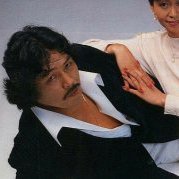
Naoki Otsuka and the Early Years of NJPW
KinchStalker replied to KinchStalker's topic in Puroresu History
Interrupting things here. This is the best stopping point I will have until I finish 1975, and I want to ask you all a question. Would you mind if I put things on hold to rewrite earlier posts? I have become extremely dissatisfied with the early numbered posts, which basically assumed that readers would already know the in-ring part of NJPW's first year, and then hopped around back and forth to cover important matches. (To say nothing of how I crammed all the young lions into one post after realizing that I had not written about them at all and panicking as I was two-thirds through 1974.) I want to expand the first post into multiple ones that put Otsuka and Shinma's valuable insights into proper context, and then put Singh, Thesz/Gotch, Powers, and Kobayashi in proper order. Which brings me to my next point. Are you all cool if I post the expanded versions on my blog instead of here? I have been piggybacking on PWO's SEO for a while now, but I think it's time for something new. I want to write nothing less than the best serial ever written about puroresu in English, and I want to be able to showcase that on my own site. -

Naoki Otsuka and the Early Years of NJPW
KinchStalker replied to KinchStalker's topic in Puroresu History
Sources used for this post include: NAOKI OTSUKA AND THE EARLY YEARS OF NJPW, #9: THE LION AND THE DRAGON The last full tour of the year was the nearly forty-date Toukon Series II. To my knowledge, the only match from this tour that circulates—besides the last, which we will get around to—is a b-show tag where Inoki teamed with Osamu Kido against George McCreary and Roberto Soto. This match was released on the twenty-disc 50th anniversary Inoki DVD set, which was later repackaged as a 60th anniversary set on four Blu-Ray discs. It’s a great shame, as this tour featured some very interesting matches. While the tour had a consistent slate of second-tier gaikokujin, there were three different top foreigners across its seven weeks, and two of those three would never work for New Japan again. (As mentioned previously in the thread, the first Karl Gotch Cup, predecessor to the Young Lion Cup, also took place during this tour. Tatsumi Fujinami won the final against Masashi Ozawa.) This photo of Ernie Ladd was used in the tour program and on the poster for the Sapporo show where he challenged Inoki. The first was Ernie Ladd. The Big Cat had wrestled fulltime for half a decade by this point after retiring from football. In spring 1970, he placed fifth in the IWE’s You Are the Promoter fan poll, which scouted interest in wrestlers who had not yet been booked in Japan. As they did with numerous names on that list, the JWA preempted their competitor, and Ladd was one of the first they booked. That autumn, for the first NWA Tag Team League tournament, Ladd teamed up with a wrestler he had only surpassed in the poll by nine votes, Rocky Johnson. That tour’s pamphlet hyped up Ladd as wrestling’s biggest “black power” since Bobo Brazil, which was true! But alas, Ladd would make far less of an impact in Japan. (The black wrestler who would truly succeed Brazil in that regard, Abdullah the Butcher, had debuted on the previous tour.) On March 21, 1974, he challenged Inoki for the NWF title in what was essentially the promotion’s final show in Cleveland. As reported by Gong in their October 1974 issue, Ladd had challenged Inoki in the locker room of the Olympic Auditorium after the tag title match. It was originally announced, in fact, that the October 10 Kuramae show would be headlined by Inoki vs. Ladd, until the Oki program was made official. Instead, Ladd got his shot at the champion in Sapporo on the first of November. It was the first time that Inoki defended the title in Hokkaido, which would not happen again for three years, and apparently, it was lackluster. Ladd’s minibio on the Showa Puroresu website reads that it was supposedly due to bad weather, while a commenter on Japanese Yahoo Answers alludes to an interview in 80s magazine Big Wrestler where Ladd claimed that he had been sick, but that Inoki had not known this and judged his performance as an unmotivated one. [Addition, 7/21/2024: Mr. Takahashi's 2001 shoot book Bloody Magic makes a claim that explains a lot: Ladd had completely forgotten the layout of the match.] Whatever the case, Inoki went over clean this time, and in postmatch comments he said this bode well for his singles match against Andre the Giant, which we will cover in due time. For Ladd’s part, his only work in Japan after this was a 1980 summer tour in AJPW, where he teamed up with Bruiser Brody to challenge for Baba and Jumbo’s NWA International tag titles. Inoki and the Sheik headlined two straight nights in Okinawa. This is from the first, November 12. Now, it is time to talk about the only six dates the Sheik ever worked for New Japan. NJPW had bought the rights to the NWF title and brand, but the room to run the promotion’s turf had gone to a far closer promoter. Ed Farhat had run Detroit’s Big Time Wrestling with his father-in-law since 1964. In the early decade, it had weathered competition from Dick the Bruiser and Wilbur Snyder’s All Star Championship Wrestling, but that was gone now. After a cancelled booking with the JWA in autumn 1971, he debuted in Japan the following year, when he challenged Sakaguchi for the vacant NWA International Heavyweight title in a pair of matches. In spring 1973, the Sheik had debuted for AJPW, challenging Baba for the PWF Heavyweight title in one of just four surviving matches from the pre-Jumbo era of the company. (Supposedly, he was booked to make up for Dory Funk Jr.'s cancellation after the shoulder injury that ended his NWA title reign.) As mentioned in #7, Farhat had voted in favor of NJPW’s membership at the 1974 NWA convention. Now, he was booked to wrestle for them for two weeks. He only wrestled one, for as soon as he had left the States, top BTW talent and staff led by booker Jack Cain left the promotion to run as International Wrestling. The dates that Farhat did work were bookended by matches against Sakaguchi: first a DQ, then a double countout. For New Japan’s second trip to Okinawa, he and Inoki fought on consecutive nights. In the first match, Inoki was goaded into disqualification, and on the following night’s lumberjack match, Farhat infamously pulled an Ernie Ladd (ha) and left the ring. He left on the 15th to sort his house back in order and did not return to Japan for three years. Andre the Giant joined the tour on its 21st show on November 19. He had worked the Big Fight Series back near the start of the year, where with the assistance of manager Frank Valois, he had dealt Inoki his first singles loss since Gotch in 1972. (Note: I incorrectly described this as a clean loss in a previous post, having not had proper information on the match. I have since corrected that.) On the final show of that tour, underneath Inoki vs. Kobayashi, he had wrestled Sakaguchi. Now, he worked the last fifteen shows of the tour, followed by NJPW’s first shows in Brazil, which we will address at the very end of the post. The December issue of Gong would have been on shelves by or around the time Andre set foot in Japan. Trust me: we need to talk about this. The magazine featured interviews with Baba and Inoki on the matter of a match. Baba admitted that the match was what fans wanted the most, and he himself thought it would be a great match that would go down in wrestling history. However, Baba said that that match would not happen because someone was challenged. He said that a unified promotion would have to be formed and that the match could be realized when they were integrated into one organization and covered by one TV station. These are things that, even in late 1974, the parties involved must have known would never, ever happen again. Showa Puroresu features a condensed version of Inoki’s caustic response. You may be familiar with the quote in which Inoki contrasted his strong style with Baba’s “showman’s style”. Well, he was long past that now. Inoki proclaimed bluntly that Baba and the Destroyer had deteriorated even further. Tiger Jeet Singh, the Sheik, Abdullah the Butcher, Andre the Giant, and the Destroyer of old were showmen: wrestlers who played to the crowd, yes, but who were competent, and who were wrestlers. “When something is called professional wrestling, the fight at least must be serious.” Inoki said that Baba-san was getting close to a “comic show” style of wrestling, of which he named the JWA undercard heels Mr. Chin and Yusuf Turk as examples. Furthermore, Inoki rejected the sentiment that the two and the styles they represented could coexist, calling it “Baba’s deception”. Baba was “the main reason why people said wrestling is what it is”. No matter how delicately Baba framed the matter, it did not dissipate the perception that he was “retreating” from a challenge that Inoki had made, even if Inoki had made the challenge without thinking through its feasibility. Now, Inoki was implying that Baba and his wrestling were an existential threat to wrestling itself. Unbeknownst to Inoki, though, Baba was about to make a major power play that would significantly restore his reputation. NWA Worlds Heavyweight champion Jack Brisco was preparing to leave the States for a set of AJPW dates when he received a call from Terry Funk. Baba wanted the belt for a week, and he was offering $10,000 for it. Brisco reminded Terry that he had paid the NWA a $25,000 bond. Ultimately, he set a bold range of terms. He would go through with the pitch if Sam Muchnick approved and if Baba paid back his bond in full. On top of that, he wanted an extra two grand for each day he was in the country and eight grand for each match with Baba. He would be in Japan for eleven days, and he would work three singles matches with Baba. For those keeping score, Brisco wanted Baba to pay over $70,000 (over $400,000 in 2023). Finally, he wanted the bond money as soon as he got off the plane, in American dollars. These were terms that Brisco did not expect to be fulfilled, and even Terry was surprised when Baba agreed. Brisco went through with the plan, but his honesty and Midwestern values compelled him to tell Muchnick, Eddie Graham, and Jim Barnett what they were going to do. When Brisco got off the plane on December 2, sure enough, the bond was right there in a briefcase. That night, as New Japan ran a provincial show in Ehime, Baba beat Brisco in Kagoshima in just under 21 minutes to become the first Japanese NWA heavyweight champion, with Pat O’Connor attending as witness. Four days later, as Inoki and Sakaguchi defended their tag titles against Andre and Roberto Soto in Osaka, Baba followed up with a successful defense against Brisco in Tokyo, where he also put his PWF Heavyweight belt on the line. Baba got his week exactly, as he dropped the title back on an untelevised show in Aichi. As Brisco learned at the tour’s end, you could not leave the country with more than five grand in cash, so he taped the stacks to his body for the long, nerve-wracking flight to Hawaii. When he landed back in the States, Brisco met in a car with Muchnick, who wanted a cut of what Baba had paid him. This moment likely contributed to the fatigue that led the NWA champion to infamously no-show the 1975 convention to force them to vote on a new champion. If so, this was a vote that Inoki held some indirect responsibility for. On December 6, Inoki and Strong Kobayashi met in a press conference to sign a contract for their anticipated rematch on December 12. Kobayashi had left for the States in spring. In between stints with the WWWF, where Hisashi Shinma had gotten him an MSG title shot against Bruno Sammartino, he had come down to work the Florida territory as the masked Korean Assassin, an associate of Gary Hart. This had led him to cross paths with Baba, who came in June to attempt to collect on the bounty that Hart had placed on Dusty Rhodes. Baba offered him a booking with All Japan, which it was not too late for Kobayashi to do, but he felt too much gratitude to Tokyo Sports for having gotten him out of Kokusai, and politely declined. In contrast to the cordial press conference before their first match, a now-mustached Kobayashi assaulted Inoki. (A 2022 Tokyo Sports article suggests that this now-standard angle had been very rare, if not nonexistent, in puroresu up to this point.) On the morning of the day, Inoki made a speech in the Noge dojo: "Do you know why I am going to fight Oki, Kobayashi, and Baba? I'm not fighting just to show off my strength. I'm fighting to show as many people as possible that wrestling, which is still seen as a show, is serious competition. Tonight, I will fight Strong Kobayashi again. Kobayashi will be even more desperate than last time, so I can't underestimate him this time. But I'm going to fight to the death, too. I have no intention of losing. That's because a New Japan Pro-Wrestling fight is always a fight to win.” Before the match in Kuramae, Inoki gathered his young lions in the locker room and reiterated his intentions: "They say that professional wrestling is a game of eight hundred tricks [a Japanese expression for a fixed sport], but I will prove with this match that it is not so. You should watch this match with an open mind. This is the kind of wrestling you have to do. We are going to restore the reputation of wrestling." Kiyomigawa, who by now had likely taken his coaching job with AJW, did not return to referee the rematch. This time, that duty fell to Corsica Jean. One half of the successful Corsicans team of the turn of the sixties, the French-Canadian was apparently recommended by Gotch. After Yusuf Turk’s acrimonious departure in 1973, New Japan did not hire a full-time foreign referee like the JWA and contemporaneous AJPW had (with Jerry Murdock in both cases). Rather, they would use the gimmick sparingly to add extra prestige to significant matches. Of course, it would be another year before Red Shoes Dugan stepped on the lion’s mat. Inoki caught Kobayashi off guard with his first offense, a pair of dropkicks and a bodyslam, and went for a pinfall which Jean counted without noticing Kobayashi’s rope break. As the crowd roared, show organizer and Tokyo Sports business head Takahashi (I only have the surname, and the guy definitely doesn’t look like later editor-in-chief Noriyoshi Takahashi) entered the ring and insisted that the match be restarted, backed by who I presume were other employees. The match was indeed restarted, and Kobayashi lasted almost half an hour before Jean called the match by referee stoppage. After this, New Japan left for Brazil. This was Inoki’s first visit in three years. At the end of 1970, he had traveled there with a NET TV crew to shoot a nature documentary, which was derailed when Inoki was bitten in the ankle by a jararaca snake. (Kosuke Takeuchi had covered his bases in case Inoki died by giving the next cover of Gong, which featured him, an unusual black background.) Brazilian immigration records indicate that Inoki had gotten his mother Fumiko back home in 1973, when NJPW received network support. I don’t know nearly as much as I would like to about this tour, as Otsuka doesn’t have anything to say about it. I am certain, though, that Keisuke Inoki must have played a major role. Gotch would tag along on the tour, wrestling his beloved pupil Osamu Kido and Masashi Ozawa. They crossed paths with Ivan Gomes. The son of a cowboy, Gomes had trained in boxing and judo/jiu-jitsu alongside his brothers, José and Jaildo, before beginning a career in vale tudo in the late 1950s. He first became known for his appearances on Heróis do Ringue, a television program hosted by the Gracie family. After this program was canceled due to an incident where João Alberto Barreto broke the arm of his luta livre-practicing opponent, Gomes moved to the show Bolsa ao Vencedor. He had a difficult relationship with the Gracies—website BJJ Heroes put it succinctly, calling him “the man the Gracies didn’t want to fight”—which ultimately ended with an offer to open a dojo with Carlson under the condition that Ivan never challenged them again. He took the offer, but his relationship with the first family of BJJ dissolved, and he handed it off to Jaildo in 1968 to return to professional fighting. By 1974, he had opened another school in his hometown of Campina Grande. First, Gomes came to Inoki to challenge him. However, he was intrigued by the training that he saw when he came to visit, and instead offered to join New Japan. Gomes would be NJPW’s first proper “exchange student”, working for them across the next two years until an infamous match on their second Brazilian tour. But the hire looked forward to the shift towards martial arts that Inoki would make in the second half of the decade, as well as the future signing of Olympian judoka Allen Coage. Inoki also met Hiroo Onoda, the Japanese holdout who had surrendered in the Philippines that same year (and, of course, the eventual inspiration for Akira Maeda’s entrance theme). On December 20, Inoki was awarded the Order of the Southern Cross from the Brazilian government. There was a photo of the ceremony in the following tour’s program, although I couldn’t find a better list than the one on Wikipedia already, which doesn’t have him. Inoki was the first athlete to receive the medal. As for the shows, NJPW held two. In Sao Paulo on December 15, Inoki wrestled his first singles match against Andre since March, and the earliest among them that survives today. It ended in a double countout when Andre walked over to the ropes while Inoki had his arm in a keylock but was tumbled over to the outside. Four days later in Londrina, Andre challenged for the tag titles again, this time with Tony Charles. Yet again, he was not enough to make up for the shortcomings of his partner. Inoki meets with famous Japanese holdout Hiroo Onoda and Ivan Gomes. -
Motoyuki Kitazawa (北沢幹之) Profession: Wrestler, Referee Real name: Motoyuki Kitazawa Professional names: Motoyuki Kitazawa, Sankichi Takasakiyama, Hirokatsu Shinkai, Shoji Kai Life: 2/15/1942- Born: Xinjiang, China (then Manchuria); raised in Aki (now Kunisaki), Oita, Japan Career: 1962-1981 (referee: 1984-5; 1991-1997; 2005-2008) Height/Weight: 175cm/94kg (5’9”/207 lbs.) Signature moves: Camel clutch Promotions: Japan Wrestling Association, Tokyo Pro Wrestling, New Japan Pro-Wrestling, UWF, Newborn UWF, Fighting Network RINGS Titles: none Tournament victories: Karl Gotch Cup [1x] (1976) NJPW charter member Motoyuki Kitazawa was a respected undercard worker for two decades, and then a referee in shoot-style. Young Kitazawa kneels in the center. Most sources about Motoyuki Kitazawa state that he was born in Ōita, the northeastern province of Kyushu island. But Motoyuki himself told a different story, in the April 1980 issue of Monthly Pro Wrestling magazine. His father's wartime work was affiliated with the South Manchuria Railway, and he himself was born in Xinjiang, the middle of three children. When Motoyuki was four, the Kitazawas moved to Ōita, where his mother's family lived. His father got a job as a woodcutter for the coal mines, cutting pine wood to add structural support to tunnels. But Motoyuki's mother left the family when he was in fourth grade. He wanted to become famous enough to find her again, and as a child, the likeliest option seemed to become a sumo wrestler. Kitazawa wrote essays in school about his aspiration and became a fan of hometown hero Daitarō Tamanoumi. According to a fan profile, Kitazawa worked as a longshoreman in Kitakyushu and Osaka. Then, around 1961, he tried to make his dream happen. Motoyuki traveled to Tokyo to seek apprenticeship under the recently retired Tamanoumi, who was in the process of opening his own Kataonami stable. But due to the "mess" involved in Tamanoumi's efforts to become independent from the Nishonoseki stable, Kitazawa was unable to even meet with him. He had no interest in wrestling for any other stable, so he chose to pivot to pro wrestling. He spent about three months living in Yokohama, where he went to the gym while working on the docks. Then he returned to Tokyo, and "ambushed" Rikidozan at the then newly completed Riki Sports Palace. Kitazawa was allowed into the JWA in October 1961. He had entered the company as Rikidozan branched out into boxing; this meant that, like contemporaneous recruit Kantaro Hoshino, Kitazawa's wrestling training was supplemented with coaching in the sweet science from Eddie Townsend. Some records state that he debuted against Koichi Hayashi on January 15, 1962. However, Kitazawa insisted this was incorrect in a 2014 G Spirits interview and claimed he had debuted on a show against Hideo Koma. Kitazawa would serve as a valet to both Antonio Inoki and Giant Baba at different points, the only person to my knowledge who did so. In summer 1963, Toyonobori bestowed a new, and rather ridiculous ring name upon him: Sankichi Takasakiyama. Sportswriter Kenta Tazaki wrote that this was a reference to the Takasaki mountain in Ōita prefecture, but I lean towards the sillier theory that I read from Showa Puroresu zine writer Koji "Dr. Mick" Mikuma, which is that Toyonobori was inspired by the Takasakiyama Zoo in Kitazawa's hometown. KItazawa with Inoki at some point after their return to the JWA. In early 1966, as Toyonobori was ousted as JWA president for his gambling addiction, he plotted to start a new promotion that he initially spun as a new, Osaka-based wing of the JWA. Alongside Tadaharu Tanaka, Kitazawa was the only JWA member who initially joined him. He later stated that this had stemmed from the invitation of Shinya Kojika, who ultimately went back on his intent to join Tokyo Pro. However, Kitazawa was responsible for inviting Masanori Saito and Masao Kimura to join Toyonobori, to his later regret. Alongside new recruit Haruka Eigen, Kitazawa would serve once again as Inoki’s attendant. When Inoki split off the entire roster except Toyonobori and Tanaka into a new Tokyo Pro, Kitazawa was named a representative director, for which he would have to deal with creditors for some time. Finally, Kitazawa and Eigen were allowed to return to the JWA in a package deal with their senpai; Tokyo Pro recruit Katsuhisa Shibata later followed them. While Masa Saito would wrestle on the final World Big League tournament in 1972, Kitazawa was the only wrestler besides Inoki who was allowed to truly return to the JWA after leaving with Toyonobori. He was also, finally, allowed to drop the Takasakiyama name. Kitazawa was among those who received instruction from Karl Gotch during his year as a JWA coach. As Kitazawa claimed in a 2014 NJPW book, Gotch expanded a shoot grappling tradition that had already existed in the Rikidozan-era JWA. Kitazawa’s comments in a G Spirits interview suggest that this “kimekko” tradition was derived from the “hooks” of Western pro wrestling. Motoyuki indicated that he first learned these from Oki Shikina, the referee and former wrestler who had coached Rikidozan in the early fifties. Kimekko also took influence from the backgrounds of two other coaches: the Kosen judo of Kiyotaka Otsubo, and the amateur wrestling of Isao Yoshiwara. When the JWA hired Gotch, he took Otsubo as his assistant and expanded the tradition, adding new holds and means of escape. Gotch taught Kitazawa how to apply a chickenwing to a larger opponent. Kitazawa’s peers have commonly regarded his skill at this form of shoot grappling. He told G Spirits that he was “often chosen” to defend the business when martial artists came to challenge a pro wrestler, and alluded to a particular incident with an Okinawan karateka. In the ring, though, Kitazawa was a consummate professional, and he did not abuse his talent to assert his dominance over inexperienced or less skilled workers. (But when Samson Kutsuwada punched him in the jaw one night, he returned in kind.) Kitazawa was an undercard stalwart who served as the debut opponent of several future legends; Masio Koma once remarked that no wrestler who debuted against him would quit afterward. In fact, Kitazawa claimed that parents of trainees attempted to bribe him to be their son's debut opponent, but it wasn't his decision, and he "couldn't take" the money. However, Motoyuki spent a lot of time on the shelf during his second JWA tenure. On July 20, 1969, at a show in Gyoda, he ruptured a ligament in his right foot during a battle royal. He returned with the new ring name Hirokatsu Shinkai in January, but just one month later, he hurt his knee during another battle royal. Kitazawa did not wrestle a full schedule again until August. It was during this time, though, that he may have made his greatest contributions to the business. First, while he was in the waiting room of an orthopedic clinic in east Tokyo, Kitazawa struck up a conversation with a lanky rikishi named Motoshi Okuma and planted seeds for the future Killer Khan's career change. Later on, he got a tip from the JWA's secretary about an applicant from Kyushu. Kitazawa came to Beppu for its hot springs and met the applicant, a 16-year-old mechanic. Kitazawa told Tatsumi Fujinami to meet up with the JWA on their June show in Shimonoseki. The rest is history. In the spring of 1971, Kitazawa's older sister regained contact with their mother. One night in May, he took a late-night cab to visit her. She was living alone in Yokohama, and after twenty years, she didn't recognize him until he told her his name. But even if Kitazawa hadn't become the next Tamanoumi, he had fulfilled his boyhood wish to find her. A month later, his mother saw him off at Haneda Airport and sent a set of necessities. Kitazawa was going to Mexico. Kitazawa before and during the only title match of his career. He is accompanied by Dr. O'Borman in the prematch photo. (Photo credit: G Spirits Vol. 58, 2020) Motoyuki was sent to EMLL to fill the spot left by Masio Koma, who had “promoted him a lot” before leaving for the US. He wrestled mononymously, under the slightly tweaked Kitasawa. He worked in a tag team with Katsuhisa Shibata, but he was also slotted into a program with Anibal, who had feuded with Koma before him. Salvador Lutteroth Jr. praised Kitazawa in a 2015 G Spirits interview, both for his skill as a wrestler and for his facial expressions. As he recalled, somebody gave Motoyuki the nickname “Jaguar”. On August 6, 1971, Kitazawa received the only title match of his career: a shot at Anibal’s NWA World Middleweight title in Arena Mexico. This show happened to coincide with the NWA’s annual meeting, which was held in Mexico City that year. Kitazawa’s boss back home, Junzo Hasegawa, was in attendance, as was Sam Muchnick. The match received substantial coverage in the Japanese press, as top reporters like Yasuo Sakurai and Satoshi Morioka were in town to cover the NWA General Assembly. Kitazawa lost the first fall but came back to win the second with a submission, which had been taught to him just before the match by Rayo de Jalisco (Sr.). However, Anibal won the last fall with a submission. In January 1972, Shibata left Mexico to work in Guatemala, leaving Kitazawa alone in EMLL. Kitazawa intended to fulfill his obligations in Mexico, but then, in the middle of the month, Antonio Inoki arrived. As Kitazawa claimed many years later, Mitsuko Baisho had called to tell him about the plan to form New Japan Pro Wrestling. He later admitted that he had wanted to continue working in Mexico, but his obligations to his senpai were paramount. There were early doubts as to whether Shibata would join New Japan, since he was in Guatemala, but Kitazawa’s involvement was confirmed immediately in the press. When Motoyuki returned to Japan, he learned that his mother had suffered a fatal stroke the week before. (A 2020 Tsutomu Shimizu article in G Spirits claims that he learned in January, but Kitazawa stated otherwise in Kenta Tazaki’s 2018 Satoru Sayama biography. I am going with Kitazawa's own testimony for now.) Kitazawa and Inoki on February 15, 1972. On New Japan's first show, on March 6, 1972, Kitazawa won his match against the Brooklyn Kid (Mike Conrad). He settled on the ring name that he would use for the rest of his career. Kitazawa had been given the name Shoji Kai by a Nichiren priest in Tokyo, to whom he was introduced by the mother of enka singer Kiyoko Suizenji. Kitazawa made a practical contribution to New Japan by connecting the promotion with Masanobu Takanashi, a Tokyo chef who had worked at the Riki Sports Palace's restaurant in the sixties and had dabbled in event promotion thereafter. Takanashi was among the very first promoters to take a chance on New Japan, and he did business with the promotion longer than Kitazawa himself would. Takanashi even fed wrestlers when money was tight. This would not be the last time that Kitazawa’s skill at networking helped his place of employment. “Shoji Kai” never became a star, but he played a crucial role. In a company that quickly developed a surplus of rookies, Kitazawa’s experience gave these “young lions” a steady hand to learn their craft. As Kuniaki Kobayashi told G Spirits in 2018, "he brought out something in me, or rather, he let me wrestle properly”. During his NJPW tenure, Kitazawa also earned a reputation as one of puroresu's best chanko cooks. Although he later developed a kimchi variation of the sumo stew, his specialty was a chanko which had been beloved by Rikidozan, and was passed down to Kitazawa by Yonetaro Tanaka. "Carefully made" with chicken stock, seasoned with soy, and sweetened by coarse fish, this so-called "sop cooking" chanko has become legendary. (In 2019, at a special event organized by writer Hiroaki Yasuda, Kitazawa got to serve a batch to fans.) From 1974 to 1976, Kitazawa entered the three Karl Gotch Cups, the original incarnation of the Young Lion Cup. He won the final one against Seiei Kimura. On April 3, 1981, after five months of inactivity, he wrestled his final match: a tag with Eigen against Kantaro Hoshino and Osamu Kido, which went to a double countout. Kitazawa received a retirement ceremony on New Japan’s famous April 23 show. After he was finished with pro wrestling, he started an interior design business. But pro wrestling was not finished with Kitazawa. In 1984, Kitazawa was approached by salesman Minoru Yoshida to join Hisashi Shinma’s new organization, the UWF, as a referee. He declined, as he did not want to sacrifice his business to reenter pro wrestling. But the two mens’ wives were friends, and that social connection gave the salesman chances to keep offering a job. When Kitazawa joined the UWF in the summer of 1984, he made a substantial contribution. The promotion needed an office and training space, so Kitazawa convinced an old acquaintance, who now ran the Daiichi Jidosha transport company, to rent out 200 square meters of his Setagaya warehouse to the UWF. But Kitazawa did even more than this, for he may very well have been the reason that Satoru Sayama ever joined the UWF. In the summer of 1983, after New Japan sales head Naoki Otsuka uncovered Inoki’s embezzlement in a shareholder’s report, Sayama and his new manager Shunji Koncha had taken part in initial discussions towards a coup d’état. Ultimately, they had disagreed with the proposed direction of forming a new company in the name of World Pro Wrestling. Instead, Tiger Mask suddenly decided to retire and then unmask on a TV Asahi variety show. Since then, Koncha had partnered with Sayama in opening his Tiger Gym. Unbeknownst to his client, though, Shunji had strung Sayama along into signing a contract that essentially gave him total control, and Koncha had aspirations to sell a returning Tiger Mask to AJPW, no matter what Sayama felt about it. Kitazawa was reportedly responsible for uncovering Koncha’s criminal past, a rap sheet with eight prior convictions. This led Sayama to leave the first Tiger Gym, start a new one with disciples Kazuo Yamazaki and Shigeo Miyato, and ultimately, to join the UWF. Kitazawa remained with the UWF for the rest of its existence, but did not follow them back to New Japan. Nor did he return for the Newborn UWF in the late 1980s. However, Kitazawa had a chance encounter with Akira Maeda shortly before the second UWF's implosion. He accepted Maeda's invitation to referee for Fighting Network RINGS, which he did until 1997. (Maeda later claimed that Kitazawa impressed Volk Han and Andrei Kopylov in a friendly spar.) Kitazawa returned to New Japan for the 30th anniversary ceremony at their May 2, 2002 Tokyo Dome show. Seven years later, he was inducted into the NJPW Greatest Wrestlers hall of fame. In the mid-to-late 2000s, Kitazawa was a freelance referee for the likes of Big Mouth Loud, Dradition, and the Showa Pro Wrestling independent events of 2008. Fumi Saito, Shigeo Miyato, Kitazawa, and Masanori Toguchi enjoy a pot of Kitazawa's chanko at Miyato’s CACC Snake Pit dojo (c. August 2018).
- 2 replies
-
- jwa
- tokyo pro (1966-67)
-
(and 1 more)
Tagged with:
-
Katsuhisa Shibata (柴田勝久) Profession: Wrestler, Referee Real name: Katsuhisa Shibata Professional names: Katsuhisa Shibata, Shibata Life: 12/12/1943-1/4/2010 Born: Kuwana, Mei, Japan Career: 1966-1999 Height/Weight: 178cm/110kg (5’10”/242lbs.) Signature moves: Mexican stretch Promotions: Tokyo Pro Wrestling, Japan Wrestling Association, New Japan Pro-Wrestling Titles: none Katsuhisa Shibata was a charter member of NJPW and remained with the company as a referee until the end of the millennium. He is also, inarguably, the most overshadowed first-generation wrestler in puroresu history. Katsuhisa Shibata worked a factory job upon graduating from junior high but joined the Asahiyama sumo stable at 16 with an athletic background in kendo and bodybuilding. Shibata remained in the Osaka-based stable for six years, competing first as himself before adopting the shikona Tessen Shigeru and Mienoyama Masahisa. (See Haruka Eigen for a photograph of Shibata during this time.) In May 1966, he left to join Tokyo Pro Wrestling along five other ex-rikishi. He debuted on their kickoff show with a loss to Hiroshi Nakagawa, the one recruit who left the business after Tokyo Pro’s first tour. Shibata remained with Tokyo Pro as it cut ties with Toyonobori and Tadaharu Tanaka and joined the IWE on its first tour. He wasn't invited to join the JWA at first, so he shared an apartment with Masanori Saito and Masao Kimura to await the call, which only he would receive. He joined Inoki’s entourage. During the 1970 World Big League tour, Shibata left for Mexico to take the place of a returning Kantaro Hoshino. His tenure for EMLL, where he worked mononymously as Shibata, was not as illustrious as that of his contemporary Masio Koma. He got a light heavyweight title shot against Ray Mendoza on August 28. One month later, on October 2, he was the first Japanese wrestler to lose a hair match against Raul Mata. After Koma left the territory to work up north, Shibata formed a tag team with Motoyuki Kitazawa. In August 1971, he and Rene Guajardo lost a hair match against Mendoza and Dory Dixon. From what I have read, the rudo style imprinted itself onto the rest of Shibata’s in-ring career. In February 1972, Inoki visited Mexico to meet with Shibata and Kitazawa. An article in Gong magazine cast doubt on whether Shibata would join New Japan Pro-Wrestling, as an unnamed executive was said to have approached him to invest in the company as an executive, which he reportedly declined. Whatever the case, he joined NJPW, and went to a double countout against Inca Peruano on its kickoff show. One year later, Shibata tagged with Inoki in the main event of the first show broadcast on World Pro Wrestling, in which they defeated Jan Wilkens and Manuel Soto. He went on to participate in the first three World League tournaments, but a shoulder injury led Shibata to retire after the first tour of 1977. He transitioned into refereeing, a capacity in which he would work for NJPW for 22 years. Two years after this pivot, he became a father. Katsuyori never saw his father wrestle, but as early as kindergarten he aspired to follow in his footsteps. During his retirement ceremony on June 25, 1999, Shibata gave Katsuyori a bodyslam as a gesture of encouragement. Katsuhisa opened the Shibata Dojo wrestling school. At one point, he also ran a New Japan merchandise store called Toy Shibata. He came out of retirement to referee on Big Mouth Loud’s first show, although he did not officiate the main event with his son (who lost to Kazunari Murakami). This was followed by appearances for Dradition and Showa Pro Wrestling. According to a blog post by the Great Sasuke, he also worked on a Michinoku Pro tour of Kyushu island at an unspecified date. On January 4, 2010, Shibata died of a stroke.
-
- tokyo pro (1966-67)
- jwa
-
(and 2 more)
Tagged with:
-
Haruka Eigen (永源遙) Profession: Wrestler, Executive Real name: Haruka Eigen Professional names: Masaru Eigen, Great Togo Life: 1/11/1946-11/28/2016 Born: Kashima, Ishikawa, Japan Career: 1966-2006 Height/Weight: 178cm/110kg (5’10”/242lbs.) Signature moves: Giant swing, piledriver, headbutt Promotions: Tokyo Pro Wrestling, Japan Wrestling Association, New Japan Pro-Wrestling, Japan Pro Wrestling, All Japan Pro Wrestling, Pro Wrestling NOAH Titles: NWA World Tag Team [NWA Central States] (1x, w/Tokyo Joe); IWA World Tag Team [IWE] (1x, w/Strong Kobayashi) Haruka Eigen wrestled lower-card matches for forty years while making important contributions behind the scenes. 17-year-old Eigen (second from left) celebrates a division win in the September 1963 sumo tournament. On his left is Katsuhisa Shibata. Haruka Eigen entered the Tachinami sumo stable at the age of fifteen, debuting in July 1961. Despite what his English Wikipedia page may say, he wrestled for five years, not four. After the May 1966 tournament, he was invited by Masao Kimura to join Tokyo Pro Wrestling’s training camp, alongside stablemates Takeji Suruzaki and Isamu Teranishi. They were joined by former Nishonoseki wrestler Tsuyoshi Sendai and former Asahiyama wrestlers Katsuhisa Shibata and Hiroshi Nakagawa. As trainer Tadaharu Tanaka had so badly misappropriated company funds that he could not afford to build a ring, he broke these half-dozen men into the business on a beach. Eigen later claimed they had made less money than civil servants and were not even fed rice. On Tokyo Pro’s kickoff show at Kuramae that October, Eigen debuted in a singles match against Kimura. While he lost, Eigen struck Kimura with a headbutt and bloodied him in a fierce brawl. He would only last five minutes before giving up to a single-leg crab, but he gave Kimura an eight-stitch wound. Although Nakagawa would leave the company after this shambling first tour, the other five joined Antonio Inoki that December when he created a parallel Tokyo Pro Wrestling company and transferred the whole roster except Toyonobori and Tanaka to it. They joined forces with the IWE on their first tour in January 1967. Eigen dines with Seiji Sakaguchi at Sakaguchis’ parents’ house in Kurume on May 4, 1969. Inoki was approached that spring to rejoin the JWA. As his valet alongside Motoyuki Kitazawa, Eigen was allowed to join in a package deal, with Katsuhisa Shibata following later. Eigen would be allowed to work under his real name while being reassigned to valet duty for Seiji Sakaguchi. According to a 2018 G Spirits article, Eigen did his job well as an undercard wrestler, with his matches against Akihisa Takachiho being considered the best curtainjerker bouts that the company had to offer. Before the JWA built its new dojo in late 1971, Eigen was compensated by Michiaki Yoshimura to let rookies bunk with him. These included Tatsumi Fujinami and the future Killer Khan. While no footage of this survives now, journalist Kagehiro Osano recalled Eigen’s memorable interference in a 1971 match between Giant Baba and The Destroyer, whom Eigen hit from behind with a chair to cause to lose by countout. As he remembers, Eigen was shown on the receiving end of the figure-four leglock on the next TV episode. He never entered that tournament himself, but he did earn the chance to participate in the third and final NWA Tag Team League in 1972, where he teamed up with Mitsu Hirai. Eigen was one of the very last wrestlers to be sent on excursion before the JWA collapsed. His destination: the NWA Central States territory, where he worked as the Great Togo. Alongside friend and fellow JWA export Katsuji Adachi, then working as Tokyo Joe, he won the promotion’s tag titles in March 1973 against Bob Geigel & Rufus R. Jones. They held them for five months before defeat came at the hands of Roger Kirby & Lord Al Hayes. [Note: Wikipedia and Cagematch both claim that Eigen worked a brief stint as the Great Togo in Tennessee in 1979, but I am absolutely certain that this was not him.] Eigen chose to join New Japan Pro-Wrestling through Sakaguchi when he returned home in October. In a company brimming with so many young lions, Eigen had a vital part to play as a veteran worker in the lower part of the card. Kuniaki Kobayashi later recalled that, alongside Shoji Kai (that is, Kitazawa), Eigen was his favorite to work with at first. Haruka was greatly respected among the roster and eventually became the president of the wrestlers’ association (representing the talent as a whole, but not like a union: it's a Japanese corporate thing). He participated in all four iterations of the World League tournament, and performed in the prelim rounds of the three MSG Series tournaments as well as the 1978 Pre-Japan Championship. In his early NJPW tenure, though, Eigen was most often seen on television in Inoki’s corner. Osano once asked Hisashi Shinma why Eigen “was always seen in dangerous places”, such as Inoki’s matches against Pak Song and the Pehlwans, to which Shinma replied that Eigen “was a sturdy man”. It is believed that Eigen may have gotten New Japan in touch with his old pal Adachi, now known as Mr. Hito, in 1979. That summer, New Japan made a trip to Calgary and essentially stole the territory from the IWE, in what Mighty Inoue suspects was Hito’s doing to strike back at rival Calgary booker Tetsunosuke Daigo. In 1980, Eigen received something of a push in interpromotional matches against the International Wrestling Enterprise. On March 31, 1980, Kokusai booked Korakuen for a major show propped up with extra network funds. In the first of the night’s four title matches, Eigen & Kengo Kimura challenged Animal Hamaguchi & Mighty Inoue for the IWA World Tag Team titles on Kokusai’s major March 31 show. This match would end in confusion as Hamaguchi slipped on a beer bottle and received a concussion when taking a tope from Kengo. The belts were vacated, and in June, a rematch with Strong Kobayashi in Kimura’s place saw Eigen win the only Japanese title of his career. They dropped the belts back two weeks later. The new decade saw Eigen help contribute to a new style called hyokin puroresu, or funny pro wrestling. Elements of comedy were nothing new in pro wrestling, or indeed puroresu, but there was something different about what Don Arakawa began doing at this time. Eigen was his perfect straight man, and the two even made guest appearances on a wrestling-themed segment of the Fuji TV variety show Hyokin Tribe, where they played JWA referee Oki Shikina and Rikidozan. In the summer of 1983, NJPW nearly fell apart in the wake of a shareholder’s report which revealed that Inoki had misappropriated company funds to pay off the massive debts incurred by Anton Hi-Cel, a Brazilian biotech startup he had spearheaded in the early decade. On July 29, Eigen was part of a meeting in Toyama to plan a coup. Kotetsu Yamamoto advocated for the ousters of Inoki, Sakaguchi, and Shinma, and the establishment of a new company named after their television program, World Pro Wrestling Ring. WPWR would have had Yamamoto and Tatsumi Fujinami as president and vice president, while Eigen would have been a managing director alongside top sales executive Naoki Otsuka. However, the rest of the parties involved in that meeting—Satoru Sayama, his manager Shunji Koncha, and salesmen Fumihiko Uwai and Minoru Yoshida—were more interested in forming a private production company that would allow wrestlers to compete in multiple promotions. Eigen meets with fellow Japan Pro personnel, including Riki Choshu. While no coup would ever fully happen, the idea proposed by the second group in that coup meeting anticipated what later came to pass. In early 1984, Otsuka was tasked with creating a production company, New Japan Pro Wrestling Entertainment, to retain the rights to the name. Eigen helped fund it, as did Katsushi Takeda. (While Takeda was originally an acquaintance of Eigen, Kagehiro Osano shot down the assumption that he introduced him to Otsuka, as he was also close with Fujinami.) NJPWE shook New Japan to its core when Otsuka decided to go ahead with an August show at the Denen Coliseum which NJPW had canceled (for a Pakistan tour) by selling it to AJPW instead. Eigen would be one of the fifteen wrestlers that decided to side with Otsuka that autumn and leave New Japan for NJPWE, which merged with Riki Production to form Japan Pro Wrestling. Takeda put up the capital for all of their contracts. So it happened that Eigen started working with AJPW in 1985, and while he wasn’t a big star on the card, he had a very important role to play. As stated by Osano, Eigen was the one who participated in booking meetings with Baba, and as the different rhythms that had developed between NJPW and AJPW—"we rock, they waltz", as Choshu famously put it—clashed violently in the AJPW vs. JPW program, that made him very important. Due to Choshu’s infamous hostility towards the pro wrestling press, Eigen also took interviews from Osano for Weekly Gong at the time, and Osano even used Eigen to get Choshu to let him interview him. However, Eigen refused to speak with Weekly Pro Wrestling when JPW boycotted them for “disproportionate coverage” (read: giving NJPW/UWF the first three covers of 1986). Eigen and Mitsuo Momota perform the “spit spot” in an AJPW match. In early 1987, Eigen was the one who told Baba about JPW’s massive internal tensions, which centered around Choshu’s desire to jump ship back to NJPW. As the company fell apart, Eigen decided to remain with All Japan. While Baba did not share Eigen’s predilection for associating with yakuza, he did have great respect for Eigen’s connections and abilities as a promoter. These connections were so valuable that, in 1990, SWS attempted to sign Eigen as a full-time sales worker, but he refused despite a generous offer because he still desired to wrestle. Between the ropes, Eigen became a focal point of AJPW’s own comedic tradition, as the core member of the nominally heel faction Akuyaku Shokai. The Fami-Aku Showdown six-man tags with the Family Gundan became a beloved staple of the All Japan house show. While the overall highlight of these matches was always Rusher Kimura’s promo afterward, Eigen was the glue that held the matches themselves together. He was most famous in this regard for his "spit spot", in which Eigen would be clubbed in the chest while standing on the apron or leaning towards it on the ropes, which caused him to spit truly impressive loogies into the audience. Front-row spectators learned to bring newspapers and umbrellas to the show. Eigen’s connections and sales acumen led him to a job as director and head of sales for NOAH. Due to the importance of this position, it is assumed that Mitsuharu Misawa had brought him on board with his plans to form the company early on in 1999. Inoki is said to have predicted NOAH’s early success when he learned that Eigen was joining them in this role. Sure enough, according to Ryu Nakata, Eigen used his pull to receive all the necessary computers and equipment to start the company for free. Eigen continued to wrestle until he turned sixty, at which point he pivoted fully into backstage work. In March 2012, Eigen and Nakata were forced to resign from the board of directors due to the revelation that they had been associated with yakuza; this seems to have been the fallout from a spiteful tell-all book penned by Jun Izumida after he was fired. Both were kept on as general employees, as Eigen continued to work as an advisor. After leaving work on November 28, 2016, Eigen collapsed in a sauna and died in a hospital shortly afterward.
-
- tokyo pro (1966-67)
- jwa
-
(and 4 more)
Tagged with:
-
Donald Takeshi (ドナルド・タケシ) Real name: Donald Leow Seng Boo Professional names: Donald Takeshi Life: 4/25/1950- Born: Singapore Career: 1968-1975 Height/Weight: 186cm/105kg (6'1"/220lbs.) Signature moves: Dropkick Promotions: Japan Pro Wrestling/JWA, New Japan Pro Wrestling Titles: none Donald Takeshi was puroresu's first "exchange student", a second-generation Singaporean wrestler. Donald Leow Seng Boo was the son of Singaporean wrestler Leow Kong Seng, whose career seems to have spanned from the late forties through the late sixties. At 17, he was encouraged by his father to drop out of the country’s oldest and most prestigious secondary school, the Raffles Institution, and wrestle in Japan. He joined the JWA during Karl Gotch’s year as coach and debuted in a battle royal on May 26, 1968. According to Mitsuo Momota, Donald quickly adapted to the setting, and he learned Japanese quickly by conversing with the young female receptionists at the ryokan where they stayed. After winning his first match against Tatsumi Fujinami on June 30, 1971, he had proclaimed that he wanted to be as famous as Donald Duck. He also stated his ideal as a wrestler, which was to be a cross between Michiaki Yoshimura and the Destroyer. Donald was conscripted into the Singapore Army two months later, but newspaper ads for early 1973 shows at the Gay World Stadium indicate that he wrestled during this time. By the time his service was done, the JWA was gone, so he joined New Japan, where he wrestled for eighteen months starting at the beginning of 1974. Most notably, he participated in the first Karl Gotch Cup on the last tour of the year, where he only managed a single win against Daigoro Oshiro. He brought a Chinese-Singaporean friend along with him, “Bruce”, who never wrestled but trained with the company for a time. Killer Khan recalled that Donald had held aspirations to become a promoter in Singapore, but these never materialized. According to a 2013 Tokyo Sports column by Kagehiro Osano, Donald found work back home as a travel guide.
-

Naoki Otsuka and the Early Years of NJPW
KinchStalker replied to KinchStalker's topic in Puroresu History
Sources used for this post include: NAOKI OTSUKA AND THE EARLY YEARS OF NJPW, #8: THE TIGER OF ASIA On March 7, 1974, Kintaro Oki held a press conference in the JWA’s Daikanyama office. As their final NWA International Heavyweight champion, he threw his hat into the ring and stated his challenge to the winner of Antonio Inoki and Strong Kobayashi’s coming match, as well as Giant Baba. Unlike Kobayashi, who had been convinced by Hisashi Shinma to leave the IWE and only challenged Baba as well as Inoki to keep up appearances, Oki was not working with either side when he made this statement. But this would change. That autumn, the last act of Oki's career would begin with a match that sent ripples through the entire wrestling world. Shinma doesn’t remember exactly when he visited Oki, but he is sure that it was after the Kobayashi match. They met three times at the Tokyo apartment rented by Oki’s Japanese girlfriend, as Oki sat near his tanning lamp. He was ready to do business with New Japan, and he told Shinma that he would hold another press conference to challenge Inoki when they were ready. He just needed Shinma to take care of one thing. Oki had developed major heat with Seiji Sakaguchi in the final days of the JWA. He had rallied against and sabotaged a full NJPW merger that Sakaguchi had helped set up to save the company. When Shinma approached Sakaguchi, he said that he would be fine with just the one match if Inoki wanted it. On June 5, by which time he and Shinma had met at least once, Oki issued challenges to Baba and Inoki. While now overshadowed by the Inoki-Oki match, some of the foreign talent hired for the Toukon Series are worth discussing. The first challengers to the Golden Duo’s new tag titles would be Nikolai Volkoff and “the Sheik of Sheik of Baghdad”, the future (General) Adnan (Al Kassie). (I will refer to him as Sheik SB, as Ed Farhat will be appearing in the following post.) A year and a half after challenging Sakaguchi for the United National title, Josip Peruzović had transformed from Bepo Mongol to Volkoff, managed by a now semi-retired Freddie Blassie. For his part, Blassie would be making his Japanese managerial debut for New Japan, twelve years removed from his infamous feud with Rikidozan but less than a year after his match against Oki at AJPW’s first-anniversary show. Blassie would continue to appear in this role with his current clients throughout the decade, but only on this tour would he also wrestle. Not only did the tour feature a relatively hot new WWWF heel, with an aging legend by his side. It also saw NJPW book a major Mexican star for the first time. Luchadores had appeared throughout the company’s history, but not counting the ersatz El Santo that Felipe Ham Lee (appearing on this tour as the Avenger) had been forced to play in 1973, none seemed as primed for Japanese stardom as Tinieblas. As least, not until the bell rang. The “Darkness” gimmick, which was conceived by legendary Lucha Libre editor Valente Pérez as an adversary to Mil Mascaras (also a Pérez invention, for those who do not know), was given to a bodybuilder and stuntman that Dory Dixon (also working the Toukon Series) and Black Shadow had scouted at a Mister Jalisco competition in Guadalajara. After his first film appearance in character, in Los Campeones Justicieros, the 32-year-old debuted in the ring after training under Dick Medrano and Rafael Salamanca. Despite Pérez’s original intent, Tinieblas would never turn into a rudo. But he had been featured in Gong, and he would come billed as El Leon Tinieblas. Unfortunately, he would disappoint a fanbase that had been weaned on three years of Mascaras tours and thus expected high-flying techniques. Until W*ING came knocking in 1991, this tour would be his only one in Japan, and it would not be until the decade was almost over that another Pérez-conceived luchador emerged as a major player in NJPW. That wouldn’t go without its own hiccups, but we are a long, long way from that story. The tour began at Korakuen on August 30. In the main event, the Golden Duo would wrestle a buildup match against Volkoff and Sheik SB. As Inoki and Sakaguchi made their entrance, Oki approached Inoki. According to a report in Monthly Gong, Oki pressed him to respond to his challenge. As Blassie heated up the crowd, and Sakaguchi waited in the ring, Oki would not let up. Finally, Inoki lost his temper and slapped Oki, sending him to the ground. Kotetsu Yamamoto then broke things up, and the match went without incident. The title match took place in Nagoya on September 10, and Oki appeared again to interfere in the match outright, but Inoki & Sakaguchi retained. On September 30, 1960, Kanji Inoki wrestled his debut match against Kintaro Oki. Fourteen years later to the day, the two signed a contract for their first match against each other in a decade, which would headline Kuramae. “The two men's gazes sparked for a moment, but they quickly turned their faces away from each other and displayed an unusual sublimation of fighting spirit.” (Monthly Gong, Nov. 1974) At one point, Oki showed off his emptied sandbag, on which Inoki’s face had been drawn. They signed in the presence of the event organizer, Hiroshi Inoue, and politician Daisuke Akita. But, of course, those are not the two men you see in the above photo. Toyonobori, who would referee the match, made his first appearance since quietly retiring the previous year. Even more interesting than that, though, was the presence of final JWA president Junzo Yoshinosato, not two months after he had voted against NJPW’s membership application in the NWA assembly meeting. As will be covered in future posts, this alliance would not even last through to the next assembly meeting. But it lasted long enough. The infamous “recommendation letter”. On October 5, New Japan released a statement signed by four JWA alumni: Toyonobori, Yoshinosato, referee Yoshio Kyushuzan, and trainer Kiyotaka Otsubo. A heavily condensed translation follows. "We, the volunteers of the Pro Wrestling Alumni, hereby recommend the following to you. Challenge the winner of Antonio Inoki vs. Kintaro Oki. […] The disarray of champions in Japan is unacceptable. At this time, we believe that you, who once held both the international singles and tag team championships and were the leader of the Japanese professional wrestling world, should take the lead in this unification. We respect Antonio Inoki's willingness to accept a challenger's challenge for the sake of the pro wrestling world. From this perspective, we request that you fight the winner between Antonio Inoki and Kintaro Ohki with dignity, and we are convinced that this will lead to the development of the pro wrestling world." Shinma took full credit for this masterstroke in the 2019 G Spirits interview. The same day it was released, All Japan ran the Nihon University Auditorium, and Showa Puroresu coverage claims that Baba’s irritation showed through in his PWF title defense against Abdullah the Butcher. Backstage, Baba dismissed the authority of the alumni by pointing out that AJPW had been created in the first place because he could no longer work with the JWA’s corrupt executives. He didn’t call out New Japan by name, but he remarked that one could tell from the letter whether it truly represented the consensus of the alumni, or just the will of “a specific organization”. Whatever the case, Gong’s final issues of the year would stoke the flames of an Inoki-Baba confrontation, proclaiming that “now was the time” for Baba to accept the challenge. Dave Meltzer, Fumi Saito and others have been correct to state that a match between these two never would have happened due to network politics. But there were points when this game did real damage to Baba’s public image, and this was one of them. I genuinely believe that you cannot fully tell this story without taking NJPW’s provocations at face value at least long enough to recount them. All Oki had was his headbutt, and Inoki knew it. In the minimalist but tremendously effective match they wrestled in Kuramae, that was made clear to everyone. Oki wore a white gown with a striking red mushroom cloud on the back; this was a reference to his signature, one-legged windup “atomic bomb headbutt”. Inoki sucker-punched him as he prepared to disrobe. After losing his debut match to Oki in 1960, Inoki had taken him to many draws in the following three years but had never won. Upon Oki’s return from excursion in 1964, he lost his first match against him to a figure-four leglock. Nine years later, and Inoki wouldn’t even let him lock it in. Inoki later recalled that, even in his prime, Oki had been stiff on the mat. All Oki had was his headbutt, and he knew it. It was a gimmick rooted in a nasty ethnic stereotype, but he trained himself to live up to it. Oki claimed that Rikidozan’s idea of conditioning was to smack him in the forehead with a golf driver. Two weeks before World Pro Wrestling’s 1969 premiere, Oki appeared on a variety show and took a chairshot to the head from Yusuf Turk, as Inoki and a group of young boys watched. (Imagine if Mick Foley had gotten brained on Regis and Kathie Lee to promote Smackdown’s premiere.) He never developed any visible callusing on the level of, for instance, a Muslim prayer bump, but he must have developed something, and it might have saved his life. Two years after this match, a car accident would send Oki through a windshield onto highway pavement, and not only did he survive long enough to get surgery, he was back in the ring less than a month later. All Oki had was his headbutt, and it wasn’t enough. After trading vertical and butterfly suplexes to end a tense, ten-minute stop-start standoff, the match culminated in a three-minute sequence of nothing but them. Oki kept knocking him down, but in the iconic climax of Inoki’s macho mind game, he called for more as blood trickled down his forehead; this moment would be repurposed as the first shot of World Pro Wrestling‘s intro. Oki finally went for the big one, the atomic bomb headbutt, but Inoki cut him off with a punch. After a body slam and a backdrop, the JWA’s final champion was pinned in 13:13. Shinma recalled in 2019 that he was irritated that Oki had kicked out just as Toyonobori’s hand had hit the canvas and had asked Inoki why he had not attacked him again. “Shinma," Inoki responded, "some wrestlers just do that.” For their part, Inoki and Oki embraced in the ring. In his 1998 autobiography, Inoki revealed what they spoke about in that moment. One had reminded the other of a night fourteen years earlier, when Oki took Inoki to a Kumamoto brothel to lose his virginity, “without incident”, on his own dime. The following evening, World Pro Wrestling drew its strongest rating yet, at 20.2%. -
I have begun work on the next entry in the Otsuka/NJPW thread, tentatively titled TIGER AND DRAGON. My plan is to cover the last four months of 1974.
Delays for resource transcription will be likely minor, but I have an interview with Strong Kobayashi which I may partially translate for comments on the second Inoki match.
-

Comments that don't warrant a thread - Part 4
KinchStalker replied to TravJ1979's topic in Pro Wrestling
Something that I can't believe I forgot to add. The government's pro wrestling budget was slashed in half in the mid-70s, as public opinion shifted to see it as the whim of a weakening administration (see: the 1974 Park assassination attempt, which managed to kill his wife). Oki had started a fishery business to make up for the lost income, but he was spending a lot of time in Japan in the mid-70s to raise money. That's actually what led to him switching to a program with Baba so soon after the NJPW Korea tour, as the Great Kojika sought him out in May 1975 to see if he was still under contract to New Japan. (Oops, guess I spoiled some future bits in the NJPW/Otsuka thread.) -

Puroresu History on Indefinite Hold [NEW UPDATE]
KinchStalker replied to KinchStalker's topic in Puroresu History
A positive update. I have just been given a 2009 HP laptop for free. Its 4gb of memory are not ideal for Kanjitomo, which uses over 900mb on its own, but I can work with them. KinchStalker is getting back in the business. -

Comments that don't warrant a thread - Part 4
KinchStalker replied to TravJ1979's topic in Pro Wrestling
I don't know as much on the subject as I would like; as I have stated elsewhere on the board, my Otsuka/NJPW thread is on hold because I am trying to get a bit more context for South Korean pro wrestling. But the industry was propped up hard by the Park regime. The president of the promotion itself, which was known as the Kim Il Supporter's Association until 1982, was Chung-hee's bodyguard, "Pistol" Park Jong-gyu. Chung-hee apparently paid for the Kim Il (later Cultural) Gymnasium, a commission which Oki hooked his architect buddy Lee Chun-sung up with. I can't verify this, but I remember reading somewhere that the promotion had lost television coverage at some point, but that Chung-hee forced it to go back on TV. In the 2019 Kim Duk interview that gave me a lot of info for the Oki/Korea post, he also notes that Jong-gyu’s wife was a huge fan and basically a patron. Oki always went out with a cadre of KCIA bodyguards. Et cetera. Everything seems to point to a simple explanation for the decline: the promotion had been coasting on government funding. I raised an eyebrow when reading Showa Puroresu state that tickets for the March 1975 Kim Il/NJPW tour ranged from 4 to 15 won, a tenth of Japanese ticket prices (that top amount equated to about ¥900 at the time). Kim Duk has this to say about his life as a trainee in 1967: “All the money for food and stuff came from the Korean Wrestling Association. In other words, money from the government. I stayed at Mr. Oki's house for about three months, but the other trainees complained, so I moved into a training camp. We young guys were paid as well. We were paid about ¥3,000 a month. All living expenses were covered by the association, so we could eat out and live on that salary. Prices were cheap.” I should also note that South Korea clearly didn’t have the infrastructure for the kind of tours that Japanese promotions did. You never read about them working in provincial markets. I only ever read about shows taking place in about half a dozen cities, the smallest of which was Pyeongtaek, which had a population of around 200,000 in 1975. Oh, and that gym? It was in the Changdeokgung Palace garden. -

[1991-01-26-AJPW-New Year Giant Series] Mitsuharu Misawa vs Akira Taue
KinchStalker replied to Loss's topic in January 1991
I've never talked about this here, but I have elsewhere online. I am convinced that the way Taue took the Tiger Driver '91, which would become the standard for the move, was not the original intention. On April 5, Misawa used the move again on a Carnival match against Kobashi in Takamatsu. As seen in a camcorder recording, Kobashi lands on his shoulder blades. Excerpt from 2019 FOUR PILLARS BIO: CHAPTERS 10-17, PART FIVE: I believe that the Tiger Driver '91 was originally conceived as a followup to the standard Tiger Driver, where Misawa drove his opponent down rather than flip them into a sitout pin. Nothing more, nothing less. This era of All Japan is marked by sequences of similar but distinct maneuvers that trade on the aesthetic benefits of repetition. Think of Misawa's multiple-suplex finishes in the early big Kawada matches. It is used in the Kobashi match in the same way, as a followup to a Tiger Driver nearfall. Misawa might be a dick here, but him going "fuck your neck, Taue" on a trial series match is out of character and out of step with the broader product. This is not 6/3/94. Perhaps the height difference between Misawa and Tsuruta/Taue led him to decide to put the move on ice. I suspect it was shelved to put over the stepover facelock as Misawa's new finish instead. But by 1994, when the nightmare bump arms race was on, I believe the move was retconned to have always been intended the way that Taue took it. (Weekly Pro coverage of the Kobashi match [special issue #432 (May 5, 1991)] did not contain a photograph of the finish, which likely obscured the contrary evidence.) I cannot confirm any of this, but it feels much more plausible to me than the notion that this superfinisher was busted out three years before it came back again. Baba, Fuchi et al. were good, damn good, but they were booking a wrestling promotion, not writing Babylon 5.- 13 replies
-
- AJPW
- New Years Giant Series
- (and 6 more)
-
This was a topic that I had not planned to write about for a while: not until I reached 1979 in the NJPW/Otsuka thread, by which time I would have properly contextualized it with all the years of politicking between All Japan and New Japan. But your friend and mine, Loss, will soon reach this point in his Wrestling Playlists Newsletter, and I cannot leave our brother in the lurch (or try to have him cram all the interesting details in there himself). This, as best as I know it, is the story of the 1979 Tokyo Sports show. On March 8, 1979, Giant Baba and Antonio Inoki met for a private Chinese dinner in Roppongi with Tokyo Sports editor-in-chief Noriyoshi Takahashi and sports department head (and World Pro Wrestling color commentator) Yasuo Sakurai. The most powerful paper in puroresu had big plans for the year, but they needed these two on board. Both men had been consulted in February, after groundwork had been laid in a meeting between top executives of all three puroresu organizations: NJPW’s Hisashi Shinma, AJPW’s Ryozo Yonezawa, and the IWE’s Toshio Suzuki. Now, Takahashi and Sakurai needed to see if they could stand to be around each other. The story goes that they left for forty minutes to see if Baba and Inoki, who had not dined together in over seven years, could get along. When they returned, the two were reminiscing happily. It would not go this smoothly for long. On May 22, Tokyo Sports representative director1 Ryotaro Motoyama used its front page to urge Japan’s three pro wrestling organizations to clash in a joint show for their 20th anniversary. Coverage of this commemorative event would give the paper the excuse to raise its price by 10 yen, which would help them make back the investment of putting on the show; since 1974, they had increased their price twice due to their role in promoting major NJPW matches (namely, the first Inoki/Strong Kobayashi match, and the Muhammad Ali fight). Most of the proceeds would be split between the three promotions. New Japan held a press conference immediately and approved. The following week, though, Baba's reluctance was made clear in comments printed by the paper. He noted that Inoki had said "terrible things" about him, that Inoki had proclaimed he would not do business with All Japan because Baba had dodged his challenge; now, they waited on Baba's call. Baba acknowledged that Inoki and New Japan's provocations may have stemmed from passion, but at worst, they had obstructed his business. When the Tospo interviewer asked if Baba wanted them to retract their previous comments, Baba denied it, but he wanted them to "be reasonable". The March dinner had been arranged with the understanding that Inoki could not walk back his years of public comments without compromising his image, and the account of that meal shows that there was still a common bond between them, but Baba still leveraged that past beef in public comments. Yoshiwara, Inoki, Motoyama, Baba, and Takahashi at the June 14 press conference. A press conference was scheduled for 11:30, but bad weather delayed Baba’s flight, and he did not land in Tokyo until 12:20. The conference finally began at 12:44, with both Baba and Inoki in a sour mood. It had been announced that the full details of the show would be revealed during the conference, but all that ended up confirmed was that the Budokan was booked for August 26. When a reporter asked Takahashi what card they had in mind, the editor admitted that he wanted to book Baba vs. Inoki. In fact, Tospo wanted to realize other top dream matches, such as Abdullah the Butcher vs. Tiger Jeet Singh and Jumbo Tsuruta vs. Tatsumi Fujinami. The tension on this point showed through in the conference, with Inoki remarking that if they were going to do a joint show, he didn’t want it to be “a festival”. But Baba played the same refrain that he had for years, and also invoked the need for a unified Japanese commission that represented all parties’ interests. Earlier that year, New Japan and Kokusai had created one between themselves, but had only asked All Japan to accept it after the fact. Speaking of Kokusai, Isao Yoshiwara noted that their joint shows with All Japan had been difficult to coordinate, and that a full three-way show would be even more difficult. Nevertheless, he was willing to do business. After the conference, the parties continued talks in a private meeting. Baba left for AJPW’s show that evening, and the Destroyer’s subsequent farewell party, but returned late that night. During these talks, Inoki was reluctant to accept the alternate pitch of a one-night-only BI-gun reunion, as he wanted assurance that this would lay the groundwork for a future Baba vs. Inoki match. As Baba was set to leave for the States, and Inoki for Pakistan, both men gave full power of attorney to others to start the booking process: Inoki to Japanese commission head Susumu Nikaido, and Baba to Tokyo Sports itself. Nikaido and Motoyama met at the House of Representatives’ 1st Assembly Building on July 4. The Funks defeated BI-gun in their final match on December 7, 1971. BI-gun’s opponents would be decided in a fan poll with a July 14 deadline. Issue #16 of the Showa Puroresu zine records the top thirty results, but the top three teams left the other suggestions in the dust: Tsuruta & Fujinami, with 34,405 votes; the Funks, with 40,876; and Abdullah the Butcher & Tiger Jeet Singh, with 41,193. Over seven years earlier, the Funks had been the team’s final opponents. Inoki had objections to another Funks match, seeing where their loyalties lied as bookers for AJPW. Perhaps speculation is irresponsible of me, but one doubts that a Funks win would have been printed if the parties involved had no intention of fulfilling it. There has been at least one confirmed case of this phenomenon, which occurred in similar circumstances. In 1995, Baba would force Weekly Pro Wrestling reporter (and AJPW creative consultant) Hidetoshi Ichinose to falsify the results of a similar poll for All Japan’s six-man tag match at the Bridge of Dreams show, whose top choice had been Mitsuharu Misawa, Kenta Kobashi, & Giant Baba vs. Toshiaki Kawada, Akira Taue, & Jumbo Tsuruta. The August issue of Monthly Pro Wrestling featured a list of predicted matches, which was likely written at a point when the Funks topped the poll. I doubt that any of the other matches had been provisionally booked when the article would have been written, but they are nevertheless worth reprinting in the footnotes.2 On July 25, a second meeting was held to discuss matches that were not the main event. The second press conference afterwards announced the whole upper card, with Baba and Inoki far friendlier towards each other. The poster was unveiled, and tickets went on sale. Ringside “A” seats went for one million yen each, with “special seats” double that (roughly $23,500 today). From there, the rest of the first floor seats ran from ¥5000 to ¥7000, and the second floor seats ran from ¥2000 to ¥4000, with a 50% discount in general seating for kids in junior high and below. On August 1, the full card was announced, and four days later, Yoshiwara stated that Joe Higuchi, Mr. Takahashi, and Mitsuo Endo would all serve as referees, alternating as primary official while the others assisted. All advance tickets were sold out by the day of the show, and the general seats all sold out on the day. Some fans had even camped out at the venue the previous night. Among those in attendance were Keiichi Yamada, the future Jushin Thunder Liger, and future NJPW announcer Hidekazu “Kero” Tanaka. 7,000 pamphlets were printed, and all sold out despite their ¥500 price; a mail-order pamphlet would also be produced. (For perspective, a Budokan show at this point in time generally only needed to print two to three thousand units, and those were priced at ¥200. The mail-order system was presumably unprecedented.) The show began at 6:20. All Japan’s ring had been unavailable due to their ongoing Black Power Series tour, so New Japan provided theirs. After speeches by (Noriyoshi) Takahashi and Yoshiwara, and an entrance ceremony, the night began with a battle royal for a ¥300000 check. 15 participants had been announced, but the final match had four more. Seven wrestlers represented All Japan and New Japan each, with Kokusai rounding things out with five. At the end of the twelve-minute match, NJPW booker Kotetsu Yamamoto made the first graduate of the AJPW dojo, Atsushi Onita, submit to a Canadian backbreaker. He said he would share the prize with him at the time, though it is unconfirmed whether he did. According to G Spirits Vol. 20, this battle royal had developed from the original idea of an Onita singles match against the young Akira Maeda. While mostly filled with rookies, Sakurai suggested that Yamamoto be added as a "neutralizing agent". Baba allegedly suggested that Bobo Brazil, who was then working a tour with All Japan, could join the fray, but this did not materialize. The first proper match saw NJPW’s Makoto Arakawa face the IWE’s Snake Amami. Nicknamed the Kagoshima Championship for their shared origins (though this moniker is confusingly shared with Arakawa’s matches against Masanobu Kurisu), the match was reportedly an effective one. Arakawa won with a hip drop. Sadly, Amami’s career would barely last into the new decade, and a brain tumor took his life one month before his 30th birthday. In the first of two matches where one half of the IWA Tag Team champions teamed with an NJPW star, Mighty Inoue joined forces with Kantaro Hoshino to face Osamu Kido & Takashi Ishikawa. At the start of the year, Inoue had worked a program with the Yamaha Brothers to win back his company's tag belts, and his being booked (by Kotetsu Yamamoto) to lose a fall by submission would influence his resolve never to work for New Japan when Kokusai crumbled in 1981. But on this night, apparently, he and Hoshino made a good team. Less so Kido and Ishikawa, as the latter's relative inexperience and sumo background contrasted with the rest of the participants. At one point, though, Ishikawa blew Inoue out of the ring with a sumo tackle. Half a decade later, those two would team up for two lengthy All Asia reigns. Next was the first of two six-man tags on the card. Ashura Hara, the last great hope of the IWE, would be working with two wrestlers on their return match from expeditions. Kengo Kimura had worked in Puerto Rico, Mexico, and Los Angeles (billed as Pak Choo in the latter two territories), and at this juncture there were hopes that his return to New Japan could replicate the Dragon Boom that Tatsumi Fujinami had triggered in the spring of 1978. (Kimura claimed many years later that, before this match, Hisashi Shinma had strongly encouraged him to receive a facelift to increase his marketability to female fans.) Akio Sato, who Kimura had debuted against in 1972, had been Baba's valet when he started All Japan, but had left for the States in 1976. There, he had mainly plied his trade in the Midwest while learning how to book from George Scott and finding love with fellow wrestler Betty Niccoli. Their opponents were Haruka Eigen, Yoshiaki Fujiwara, and Isamu Teranishi. According to Showa Puroresu's show recap, Sato gave a disappointing performance, perhaps not helped with being paired with the likewise dry Eigen. I will allude multiple times to a roundtable discussion on the show that was published in Gong, which featured all three active Tokyo Sports reporter-commentators (Sakurai, Takashi Yamada, Takashi Kikuchi) as well as puroresu journalism pioneer Hiroshi Tazuhama. Someone on that panel went so far as to say that Sato had regressed since leaving for his excursion. Kimura would be pushed as a major junior talent in the year to come, which would culminate in a run with the NWA International Junior Heavyweight title. Sato would not make a proper full-time return to Japan for two years, but would become an important figure in AJPW’s reinvention in the new decade, working behind the scenes as a booker and on-site supervisor. The match had a safe ending as Hara pinned fellow Kokusai talent Teranishi. The fifth match of the night is the last one that, to my knowledge, does not exist on tape. (Showa Puroresu writer Dr. Mick—who I am certain did not attend this show, as I know he’s from Osaka and he would have been just a child—implies in his show coverage that he has seen video footage of the previous match, which suggests that there is either more footage from the same taper that I will address soon, or an alternate recording.) It’s a shame, too, because it features the one interpromotional dream team that actually had a future. Animal Hamaguchi had spent two years as an IWE tag champion, built up by a reign alongside Great Kusatsu before teaming up with Mighty Inoue to form one of the most definitive (and certainly the most chronicled) IWE teams. But tonight, he shared the corner with Riki Choshu, two months after Choshu had won the NWA North American tag titles alongside Seiji Sakaguchi in Los Angeles. On the other corner, Motoshi Okuma & Great Kojika represented All Japan. They had Choshu in their control in the first half, but the debuting team got something going against Kojika. While he was helpless in Hamaguchi’s airplane spin, Okuma intervened and then assaulted Mr. Takahashi to lose by foul play. Match #6 was the second singles match of the night, and the first match on the audience recording in circulation. On one end was Seiji Sakaguchi, probably New Japan’s #3 star. On the other was prominent AJPW midcarder Rocky Hata. It may not surprise you to learn that this match was not the original plan. Although it had been announced at the August 1 press conference, it is known that Sakaguchi’s original opponent was IWE booker Great Kusatsu. Kusatsu shot it down, as Showa Puroresu reported in 2008 and as then-valet Masahiko Takasugi confirmed in a late-2010s G Spirits interview. I happen to have the issue with the Takasugi interview, but I had not scanned it before my scanner broke, and I do not have access to my transcription method. So I cannot give any more details from Takasugi. But Showa Puroresu notes that Kusatsu was frequently mistaken for Sakaguchi, and that his refusal may have been a petty one along these lines. I feel that not wanting to work a match that one had not booked themselves could be a plausible explanation, but everything I know about Kusatsu suggests that the SP account is possible. Kusatsu attended the show. Hata was reportedly nervous, and had spent the whole night before drinking. He lasted six and a half minutes before a jumping knee and atomic drop ended his misery. In the Gong roundtable, Kosuke Takeuchi asked Sakurai outright if they really could not have found Sakaguchi a better opponent. Sakurai said that Jumbo Tsuruta, Rusher Kimura, Kusatsu, Tiger Toguchi, and others had been considered, and credited Inoki with suggesting Hata. The second six-man followed. Jumbo Tsuruta, Tatsumi Fujinami, and Mil Mascaras joined forces in a boy fan’s dream against a trio of lone wolves: Masa Saito, Akihisa Takachiho, and Tiger Toguchi. The babyfaces would be dubbed the Bird Men Trio, and all three got to show their unique styles. This match had developed from the original Fujinami vs. Tsuruta pitch, which Baba had rejected. After Baba had also rejected a Fujinami-Tsuruta tag match, Sakurai suggested that Mascaras be added, and Baba finally approved. One must commend Saito and Takachiho in particular, who had recently worked alongside each other in Florida. The future Great Kabuki had joined AJPW on its then-ongoing Black Power Series tour, making his first appearances in Japan since early 1978. He had left out of disillusionment over Samson Kutsuwada’s attempted mutiny, and it has been speculated by Dr. Mick that both Takachiho and Kazuo Sakurada had been eyed by Hiro Matsuda to effectively jump ship to New Japan the previous year, in what became the late-year Okami Gundan angle. (Mick cites a tip in a 1978 issue of Gong where a Mr. S and Mr. T claim that they want to work for NJPW.) While this show could never have happened with a conventional broadcast deal, production masters were created for the top three matches. These were for news programs, which would be allowed to clip up to three minutes for their reports. A production master of this match was created with the AJPW broadcast team of Takao Kuramochi & Takashi Yamada. This leads one to presume the agreement was that Nippon TV-affiliated networks could only air clips from this match, due to their contracts with the network. While the full tape has been lost to history—NTV once stated that they still had the edited version they aired on the news, though I have never seen it—we can see it on the fancam, and it holds up the best of the matches available to us. It's certainly better than what followed. As Sakurai admitted decades later, Isao Yoshiwara was reluctant to have his ace, Rusher Kimura, wrestle Kokusai deserter Strong Kobayashi in a grudge match. At the time, though, Sakurai credited Yoshiwara with pursuing the match in the Gong roundtable. Even the Kokusai devotee Dr. Mick doesn’t mince words; this one was a dog. Mitsuo Endo was the main referee, which bred concern about his loyalties. The crowd was about seventy percent in favor of Kobayashi, who lost by ringout. No matter how much Kimura protested on the microphone that he would challenge his former tag partner “anytime”, it was not a good look for the tragic ace, who was only eighteen months removed from one of the most humiliating losses in the history of puroresu against Baba. Yoshiwara had been willing to compromise his top stars for years due to his dependence on interpromotional matches for the cash flow from better-paying networks, such as Rusher’s early draws against Jumbo Tsuruta and Mighty Inoue’s clean loss to Tsuruta in the previous year’s Japan League tournament. If he was hesitant now, it was too late, and his company’s image cannot have been helped by this result. Kobayashi had relinquished his spot as Sakaguchi’s tag partner to Choshu, and the last major matches of his full-time career were in association with Kokusai. Plans were made for him to team up with the Rusher-led Kokusai Gundan heel faction in 1982, but Kobayashi’s pivot into entertainment made them moot. A production master was created by Tokyo 12 Channel, presumably with the Kokusai Pro Wrestling Hour commentary team of Shigeo Sugiura & Takashi Kikuchi, but it is now lost. Finally, BI-gun reunited one last time. Abdullah the Butcher and Tiger Jeet Singh had been the definitive foreign heels of their respective stomping grounds. Abdullah had debuted for the JWA in 1970. It was when he and Baba wrestled in the 1971 World Big League final that Inoki held the infamous impromptu press conference where he first challenged Baba. Since then, he had become AJPW's most popular heel, and this was the year where he worked five of the promotion's ten tours. Singh, meanwhile, was NJPW's first genuinely homegrown heel, a committed character wrestler who garnered massive early heat and had stayed relevant since. A production master was created with the World Pro Wrestling commentary team of Ichiro Furutachi & Yasuo Sakurai, with Sakurai's future successor on color commentary, Kotetsu Yamamoto himself, sitting in. A dupe of this tape eventually got into fans’ hands. (It had been available on YouTube but was taken down by NJPW. Only the abridged news report version is on there at the time of posting. But I trust you can find it yourselves.) After thirteen minutes, Inoki got a Joe Higuchi three-count on Singh with a bridging German suplex. After the match, Inoki grabbed the microphone. "Thank you all very much for coming today. Earlier, [PWF] Chairman Lord Blears gave me a very kind word to make the Baba-Inoki fight a reality. I am willing to risk life and death to make this fight happen. I will continue to work hard so that I can fight Baba. The next time the two of us meet in this ring, it will be time to fight!" Baba had no choice but to play along, exclaiming “let’s do it!” in response. This carried over into the subsequent press conference, where Baba acknowledged that there were still issues, but claimed that “he didn’t care about them now”. In truth, though, Baba had taken this as a sign that Inoki still could not be trusted. A 2022 column on the NJPW-AJPW rivalry by Kagehiro Osano reports that Baba had come to this conclusion due to a private telephone conversation the two had had a few days before. While this may or may not be the same incident, a recent article by Gantz Horie sees Shinma claim that the night before the event, Inoki had suggested to Baba that the match’s finish be changed to have them go over one of the two heels clean.3 The next day, Tokyo Sports hit the shelves with its new ¥50 price. FOOTNOTES
- 1 reply
-
- ajpw history
- njpw history
-
(and 1 more)
Tagged with:
-
Jumbo Tsuruta plays one of his "recital" fan concerts. Accompanying on his left is Jimmy Suzuki, president of the Jumbo Tsuruta Friendship Club, charter member of the influential Maniax club, and a future photojournalist, reporter, and promoter.
-

Puroresu History on Indefinite Hold [NEW UPDATE]
KinchStalker replied to KinchStalker's topic in Puroresu History
Bad news. Funds for a new laptop are much more limited than I expected. There are some posts that I plan to write in the interim, such as one about the Tokyo Sports show which Loss will soon reach in his newsletter. But as before, I cannot process much of the resources I have acquired, due to my inability to type Japanese. As earlier stated, I refuse to continue the NJPW thread until I can transcribe a Pak Song serial that should give me context on the South Korean promoters that Oki competed with, and who Inoki later worked with. -

Comments that don't warrant a thread - Part 4
KinchStalker replied to TravJ1979's topic in Pro Wrestling
Early puroresu music's love of cheesy slick jazz fusion made that stuff grow on me. NJPW had three guys come out to disco-era Maynard Ferguson at some point, one of whom was Hogan. AJPW's producers loved stuff orchestrated by Richard Hewson because he did the strings on "Sky High" (you are not ready for Dick Murdoch's theme from that period). There has to be an alternate timeline where Herb Alpert's "Rise" doesn't become a #1 hit off of General Hospital and thereby becomes cheap enough for one of the networks to license. -

Comments that don't warrant a thread - Part 4
KinchStalker replied to TravJ1979's topic in Pro Wrestling
RIP to Johnny Powers, who reportedly passed away on the 30th. Here is a Greg Oliver obit. -

AEW TV 1/4 and 1/6 - The One Where Danielson Wrestles Nese
KinchStalker replied to Timbo Slice's topic in AEW
On transit to BOTB now. It's my first wrestling show since a 2006 Smackdown taping, so as far as I'm concerned, I have the right to cut a little loose. -
Gogeum sits about a mile south of the tip of the Goheung Peninsula. Its 63 square miles, bolstered by reclaimed land in the northwest, make it just a little bigger than Chicago. Kim Tae-sik was born in Gogeum in 1929, as his country sat beneath the “black umbrella” of Japanese annexation. Little of the island itself is arable, so Kim’s father farmed green laver. Although this practice has declined significantly in recent decades, it is likely that he did so using the traditional ‘racks’ method. Every year, he would have planted bamboo in the seabed. Then, he would have affixed nets to the sticks to catch floating laver seed. These nets would then be arranged in racks on the farm, submerged in high tide but exposed to the sun on low tide, and the seaweed bred from winter through spring. It’s a demanding process with low yield, and it should be little surprise that the Kims lived in poverty. Kim (center) with a calf won in ssireum. (September 1956) Tae-sik was the eldest of five. His future valet, Masanori Toguchi (Kim Duk), recalled the names of all but the third. Kwon-sik was the second, Yu-shik was the fourth, and Kwang-sik was the fifth, born in 1952.[1] As a child, Tae-sik had wanted to join a sumo stable in Japan. He would later compete in local ssireum tournaments where the prize was a calf. The legend goes that he won 27 of these, but Toguchi thinks this is an exaggeration. Tae-sik married Park Geum-rei when he was 16, and the two would have two sons and two daughters.[2] While Kim would have been able to watch wrestling on Japanese televisions in the Busan area, this isn’t what tipped him off to the existence of Rikidozan. Japan and the Republic of Korea had no diplomatic relations, but their fishery industries still did business together. It was a sailor at the Yeosu port who showed Kim a wrestling magazine. He made the hard decision to leave his family and smuggle to Japan on a fishing boat. The voyage from Yeosu to Shimonoseki, the city at the southwestern tip of Honshu, took 20 hours. Kim made it to Osaka and took a train to Tokyo, where he was arrested. Kim did time in a special prison for stowaways in the Kyushu city of Omura. He wrote a letter to JWA commissioner and Liberal Democratic Party politician Banboku Ōno, appealing to join the promotion. After nine months in jail, he was essentially released into Rikidozan’s custody in April 1958. The truth of these circumstances was not revealed for some time, as a 1961 Pro Wrestling & Boxing article claimed that Kim was a failed businessman who came to Rikidozan’s home and asked to join the JWA. It was not until the 1972 Gong serial “Tiger of Asia”, written by JWA Commission secretary general Shigeo Kado, that the real story was publicized. (This was one example of how Kado's writings, while likely sensationalized, were the most revealing of early puroresu journalism.) He was given the ring name Kintaro Oki. Kintaro, or “Golden Boy”, is a folk hero: a boy with superhuman strength.[3] Billed as being four years younger than he really was, Oki debuted in November 1959 as the second of puroresu’s first “four pillars” (after Yukio Suzuki). The following year, he was the debut opponent of one Kanji Inoki. Oki took well to Inoki backstage, believing at first that he was really Brazilian and bonding with another outsider. As Inoki disclosed in his autobiography, he lost his virginity on Oki’s dime in a Kumamoto brothel. Inoki wrestled him numerous times throughout the first four years of his career, eventually taking him to many draws but never beating him. [Note: I will be referring to Kim as Oki henceforth, for ease of reading.] In September 1963, Oki left for an American excursion; the story has long gone that it was originally intended for Inoki, but that a knee injury caused him to be passed over. Billed as a Japanese native, Oki teamed up with Mr. Moto in the WWA and won their tag titles from Bearcat Wright & Red Bastien on December 10. During this stint in Los Angeles, he created what would eventually become his Korean stage name. One night at a Korean diner, Oki met UCLA student architect Lee Chun-sung and introduced himself as Kim Il. Lee would connect him with the local Korean community, who attended his matches at the Olympic Auditorium. A decade later, Lee would design the Cultural Gymnasium in Seoul, which was initially owned by Oki's promotion. Oki at Haneda Airport in January 1964. After Rikidozan’s death, Oki returned to Japan on January 24, 1964. He had done so without permission, but was nevertheless allowed to work for them starting in February. He competed in the 6th World Big League, losing against Gene Kiniski and Caripus Hurricane to notch three wins, two losses, and one draw. On a Sapporo show on May 28, he debuted a ring name that he would work under intermittently for the rest of the decade, Kintaro Kongo (金剛金太郎). It was said at the time that he wanted to avoid confusion with head referee Oki Shikina, but this name had apparently been thought of by Rikidozan. According to Toguchi, Kongo was a reference to North Korea’s Mount Kumgang (금강산/金剛山). Top figures in the political and criminal spheres are involved in this story. Top to bottom, left to right: Park Jong-gyu, Yoshio Kodama, Park Chung-hee, Hisayuki Machii, and Kim Jong-pil. Oki returned to Korea for the first time in six years on June 27. According to his autobiography, he had come into contact with an agent of the Korean Central Intelligence Agency, who asked if he wanted to meet President Park Chung-hee. Smuggling to Seoul for ten days, Oki did not meet Park. He did, however, meet KCIA director Kim Jong-pil. Three years earlier, Kim had engineered the coup in which Park had seized power. He was an associate of Hisayuki Machii, the Yakuza godfather who ran the Tosei-kai and held the rights to promote JWA shows in the Tokyo market. Kim asked Oki to become “the Rikidozan of Korea”, and that would be taken rather more literally than one might imagine. Machii and Yoshio Kodama—ultra-nationalist, power broker, and president of the JWA’s shareholders organization—pressured the JWA in a summer meeting to allow Oki to adopt Rikidozan’s stage name in Korea. While the recently deceased Bamboku Ono had opposed the effort for Japan to sign a treaty with the Republic of Korea, these two strongly favored and facilitated it, as they stood to gain a cut of the investments that reparations money would go towards. Alongside the casinos and cabarets they would open in Seoul, it is clear that they planned to replicate the Rikidozan formula with Oki. In fact, they were carrying out what Toguchi suspects Rikidozan had intended all along. Rikidozan had visited South Korea at Kodama’s insistence in January 1963, and the Korean side had wanted him to hold and wrestle in an international tournament there. Rikidozan would never have agreed to this due to the risk that it would expose his secret in Japan.[4] As top wrestler-executive Junzo Yoshinosato later recalled, the only way that they got out of the demand was by setting an impossible condition. They would allow Oki to adopt the name…if he defeated the NWA World Heavyweight champion. After a brief return to Japan in August, reverting to his first ring name, Oki returned to the States in September and, well, he tried. On October 16 in Houston, he got a match with the NWA champ, a 48-year-old Lou Thesz. He went off-script with a shoot headbutt and was beaten and bloodied for it, to the tune of 24 facial stitches. While I do not know whether Thesz was ever made aware of the political context of Oki’s actions (I’m sure Koji Miyamoto could have told him the story at some point), the two would become friends. Thirty years later, Thesz pushed Oki’s wheelchair for his retirement ceremony, which took place during Weekly Pro Wrestling’s Bridge of Dreams show at the Tokyo Dome. Oki returned to Japan in June 1965. On June 11, though, the JWA expelled him for the match with Thesz, as he had gotten it booked through former JWA talent booker Great Togo. Togo was persona non grata in the JWA since he had extorted them for solatium after Rikidozan's death, which they only granted with his promise never to work in Japan again. Just two weeks later, Japan and the Republic of Korea signed the Treaty on Basic Relations. That same day, Oki met with Toyonobori in Tokyo. There is a factor that I have not discussed yet. Oki would be encroaching on another promoter's territory. Jang Yeong-chol and Chun Kyu-deok, the pioneers of Korean pro wrestling. Pro wrestling had existed in South Korea for four years. Jang Yeong-chol, a wrestling coach, and Chun Kyu-deok, a serviceman who taught taekwondo at night, had seen Rikidozan on Busan television. They had no one to properly teach them, so they had to learn secondhand.[5] They apparently ran first in Busan before taking their operation up to Seoul, in which they held their first show in June 1961. (Two months earlier, a trio of former JWA wrestlers—Osamu Abe, Takao Kaneko, and Mitsuo Surugaumi—had run a pair of Seoul shows.) They eventually earned the support of President Park Chung-hee, who expected them to run once a month at the 10,000-seat Jangchung Gymnasium once it was opened in 1963. Jang's promotion was built on matches against Japanese talent unaffiliated with the JWA. He did business with a group led by former AJPW Association wrestler Hisaharu Kaji, which as mentioned in Interlude #3.1 of my Naoki Otsuka/NJPW series included Mr. Takahashi.[6] In December 1964, they received network backing when Tongyang Television launched, thanks to future Seoul Olympics production director Kim Jae-gil. Jang would surely be interested in a JWA partnership, and Oki could not let that happen. Ultimately, Oki was successful. He wasn't brought back into the JWA, but he intended to wrestle in Korea anyway. Jang and Chun would be forced to work on his terms. On June 30, he landed in Seoul Airport to a hero's welcome. In the two months before Oki's Korean debut, Jang struggled with tensions in his ranks, particularly as to his top prospect. Pak Song-nam, a 6'6" giant he had scouted two years before, refused to swear loyalty to him. In early August, Jang allegedly had Pak abducted and held without food or water in a secluded mountain cottage near the Korean Demilitarized Zone. He was found after five days by a military patrol. Late that month, Oki wrestled as Kim Il for the first time in the Far Eastern Heavyweight Championship Tournament. He brought four JWA wrestlers with him: Yoshinosato, the former light heavyweight champion soon to become JWA president; Michiaki Yoshimura, the best worker of puroresu's first generation; undercard stalwart and onetime coach Hideyuki Nagasawa; and Umanosuke Ueda, a bone-dry technician yet to discover his voice as a heel. The Korean end of the tournament was Kim, Jang, Chun, and Pak. Oki defeated Yoshinosato to win the tournament and the eponymous title. An article states that "pro wrestling is a show". Three months later, the World Big League-inspired Five Nations Championship Tournament was held. The same four Koreans in the previous tournament competed against representatives of Japan, Turkey, Sweden, and Denmark. Yusuf Turk, who helped book the tournament alongside Oki and Shigeo Kado, represented Turkey. Karl Karlsson, seen donning a leather helmet in newsreel footage, represented Sweden. Denmark’s Viking Hansen was the future Erik the Red. Finally, three-year veteran Motoshi Okuma stood in for the JWA. On November 25, Jang and Okuma wrestled in a tournament match that went south when Okuma cranked back on a single-leg crab and Jang’s posse stormed the ring to break it up and beat him. The particulars of what happened next appear to have been misunderstood in decades of Japanese accounts. Their narrative went that Jang exposed the business to the police to keep his boys from being arrested. Chun asserted in a late-life interview that it had happened somewhat differently. Jang had kept his mouth shut, but the police had taken his silence as a confirmation. Regardless, the next day’s papers read that “pro wrestling was a show”. Jang lost his support from Park Chung-hee, and the dojo built for him in Seoul’s Samgakji area was taken over by Oki’s group. Jang’s faction also switched sides. In December, Oki defended the Far Eastern Heavyweight title against Ripper Collins. This was the first time that South Korea booked an American talent independently of the JWA, and with the financial backing of a dictator, it would not be the last. President Park's right-hand man, Park Jong-gyu, became the president of the promotion, named the Kim Il Supporters' Association upon its formation in 1967. FOOTNOTES
-

Puroresu History on Indefinite Hold [NEW UPDATE]
KinchStalker replied to KinchStalker's topic in Puroresu History
Just wanted to give an update. It looks like I will be able to get a new laptop soon, but I am waiting for the funds to come through. I have a computer available to me, but I do not have the authority to install Java on it, which Kanjitomo runs on. (I tried a mobile app called Kaku, but I just could not get a good workflow going with it. Even more than Kanjitomo, it was clearly designed for manga and visual novels, not dense text.) I have written over 2000 words of what originally was supposed to be the next entry in the NJPW/Otsuka series, which would at least cover the Kintaro Oki match. But 2000 words of that have wound up being solely about Oki's early career and the birth of Korean wrestling. I am preparing a thread solely devoted to that, so that I can get this information out there without bloating the Nooj series. What I have written goes up to the end of 1965. -
Major Update: This profile has been expanded with information from a 2019 G Spirits article by Etsuji Koizumi. This was the last Japanese resource that I was working on when my laptop went under, and I had transcribed about 85% of it. I plan to complete it when I have a computer to use Kanjitomo with again.
-
Agreed. As a side note, the first-gen puro guy with the best reputation as a worker is Michiaki Yoshimura. He's solid in what I've seen, but we just don't have that much. The story goes that he was so good as a FIP that his daughter got bullied at school for how weak he was.
-

Puroresu History on Indefinite Hold [NEW UPDATE]
KinchStalker replied to KinchStalker's topic in Puroresu History
Bad news, brothers. The laptop is, indeed, FUBAR. I don't know when I will be able to get a new one. Any transcription is off the table for a while.
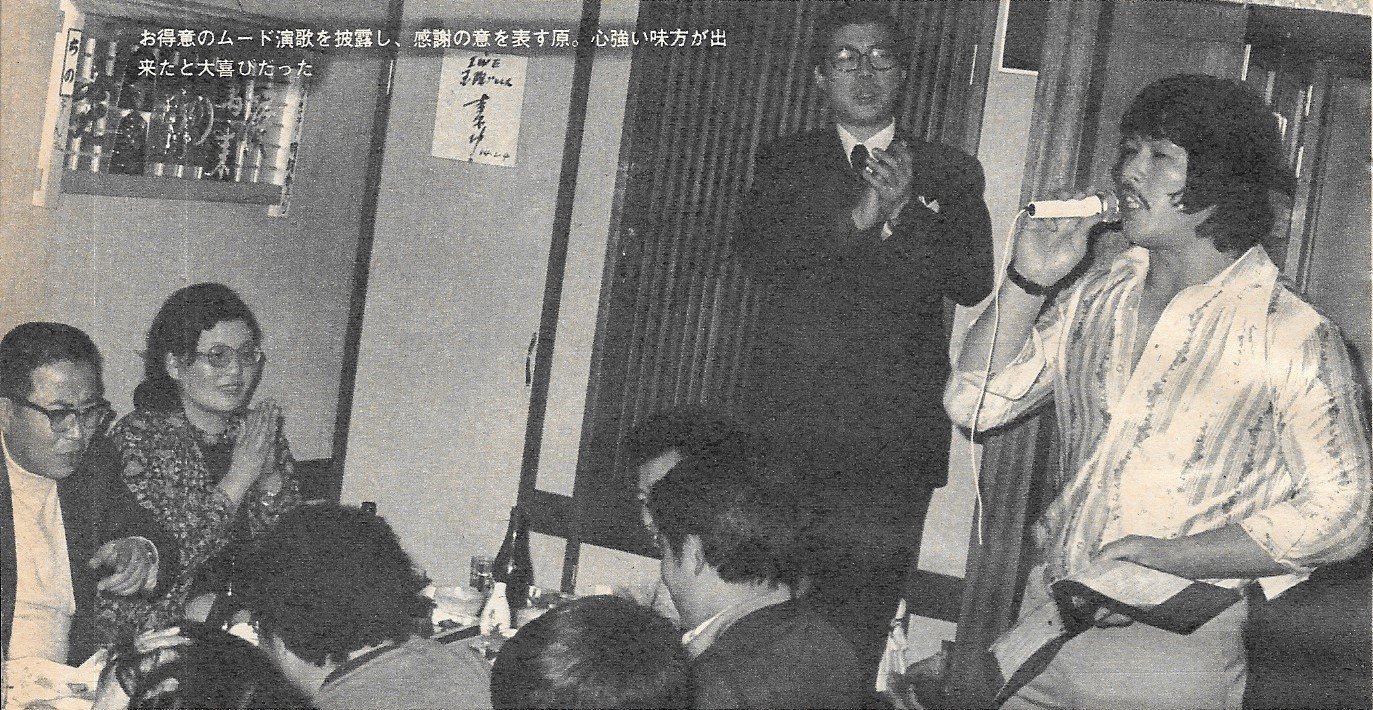
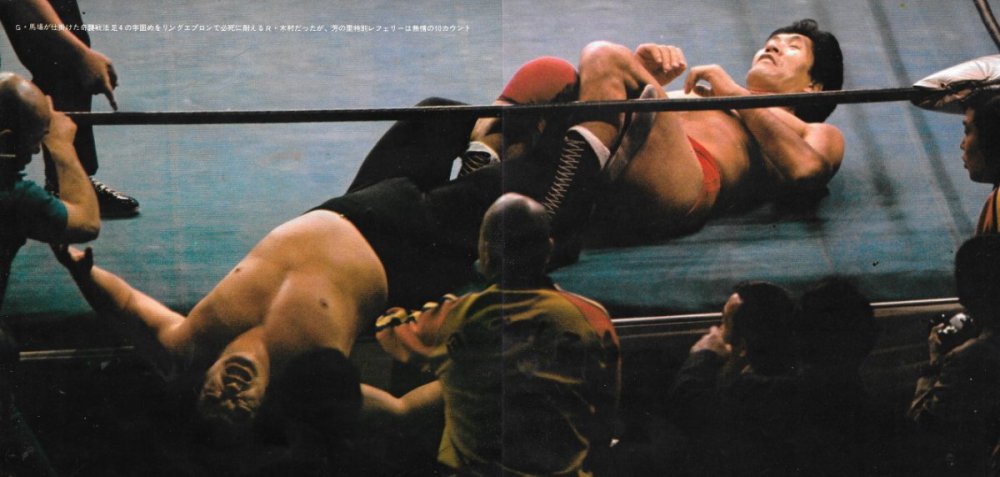
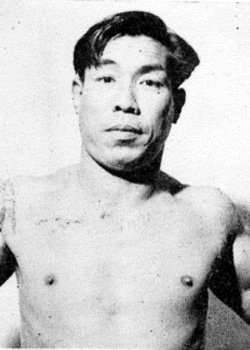
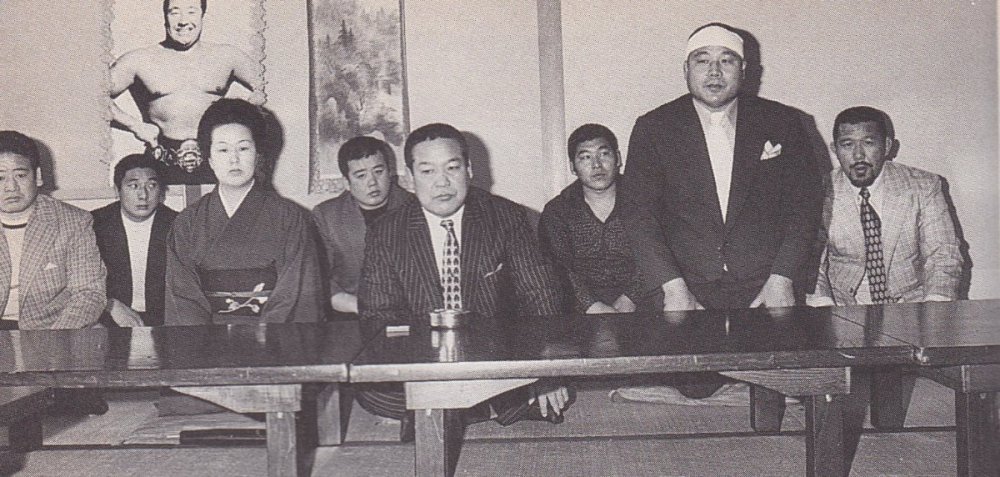
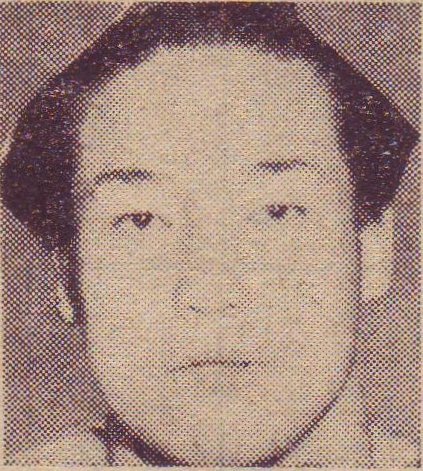
.jpg.3c2a4e3040acc417cd2632d5e8ef2dc1.jpg)
.jpg.044bc18a5e739da325556a5e20aea569.jpg)
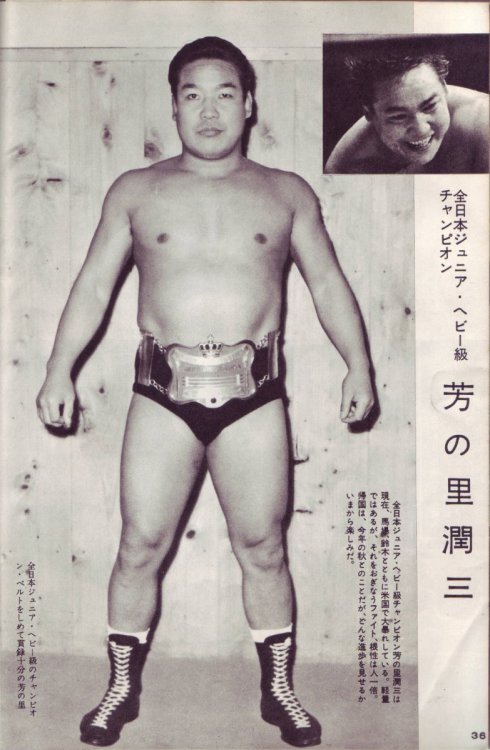
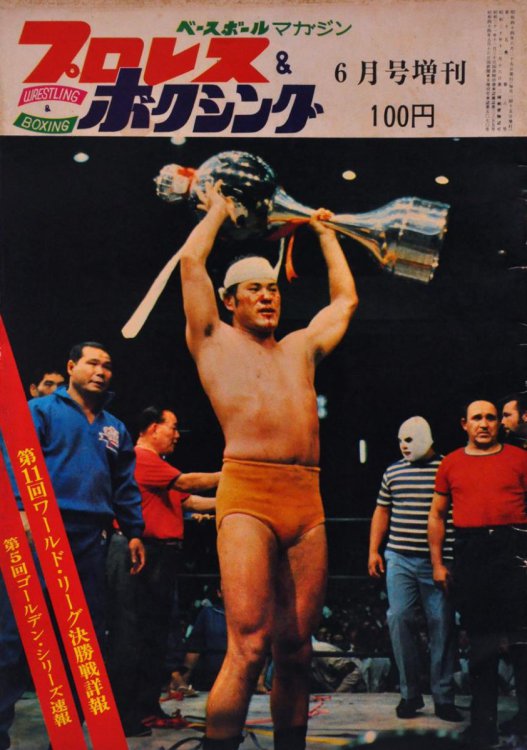
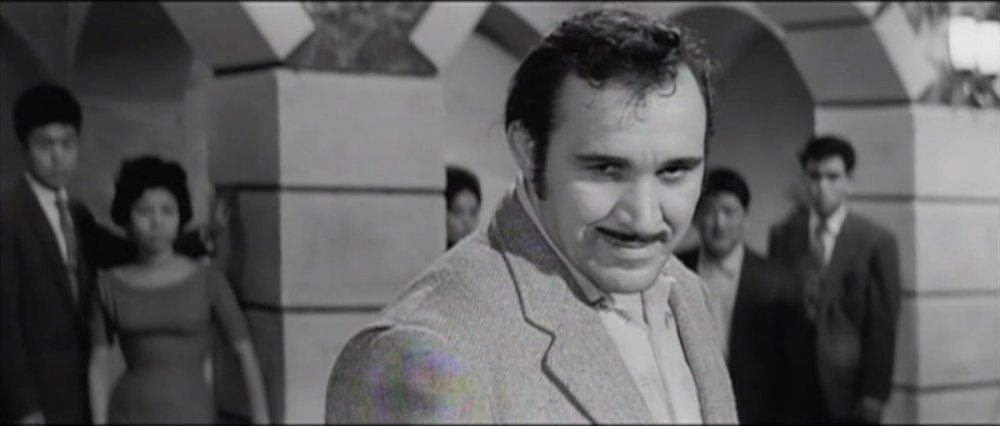
.thumb.jpg.0eb4172e6e07b54c46b26787e6625f54.jpg)
.jpg.a5bb2d6316460bd3b0f1439f20fbc653.jpg)
.jpg.27c211787352f13e3d4e061b233e6b4b.jpg)
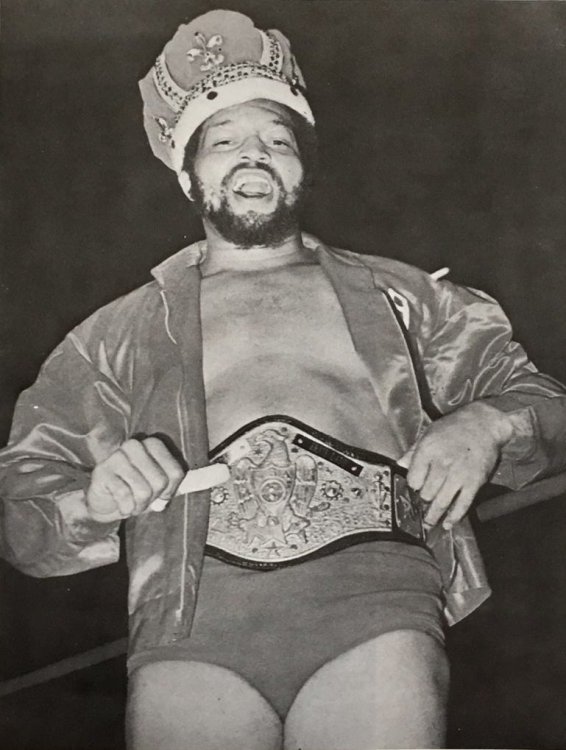
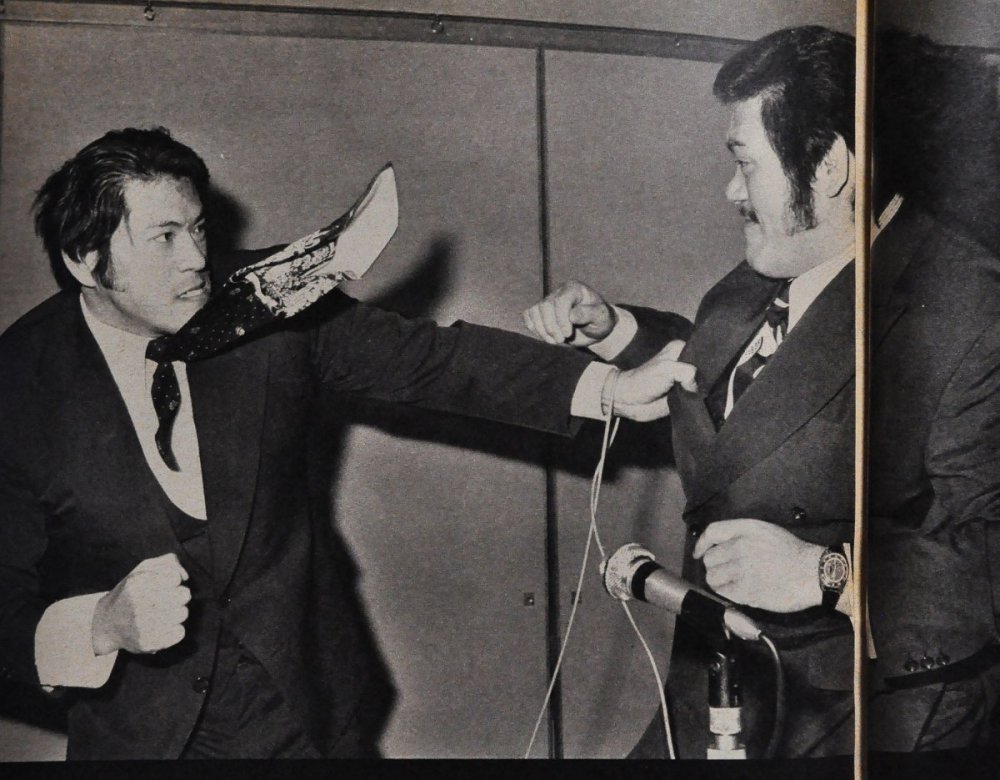
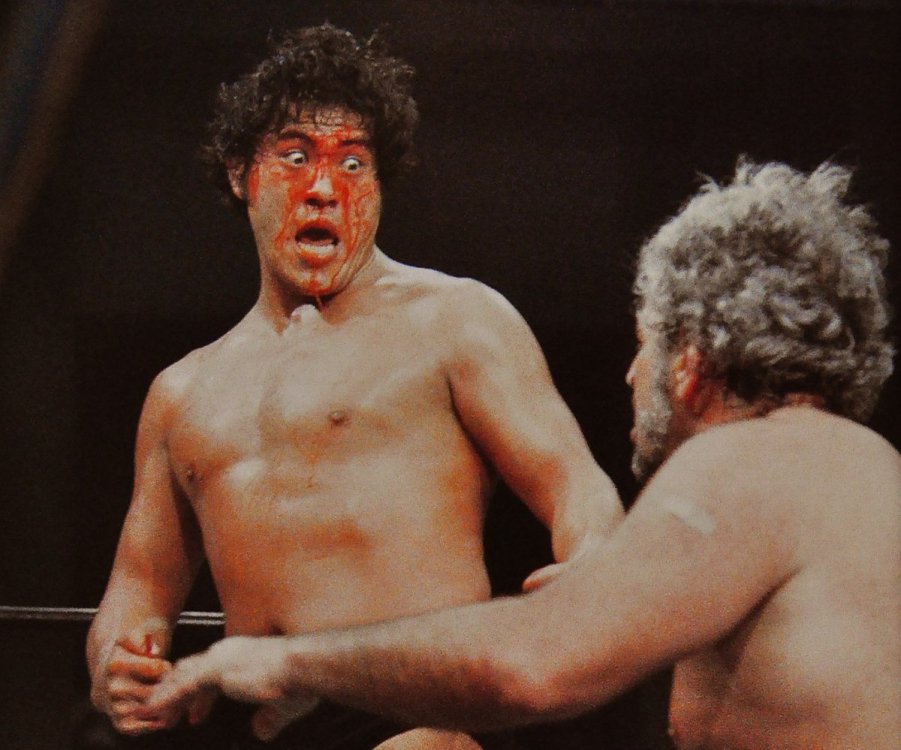
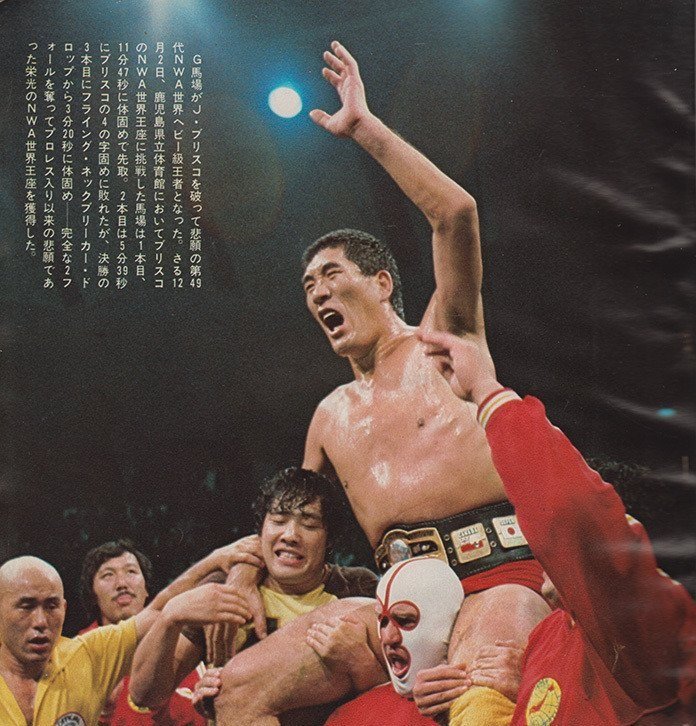
.thumb.jpg.541ab8e466b7ba82ab4b72864fed04fd.jpg)
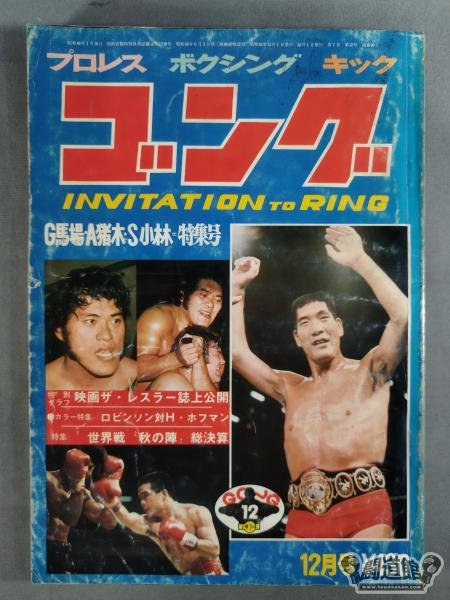
.jpg.a0a958e75a60240faa571d2cd3ffc3ef.jpg)

.thumb.jpg.0a401c992ebfc174622a20ce08cbc660.jpg)
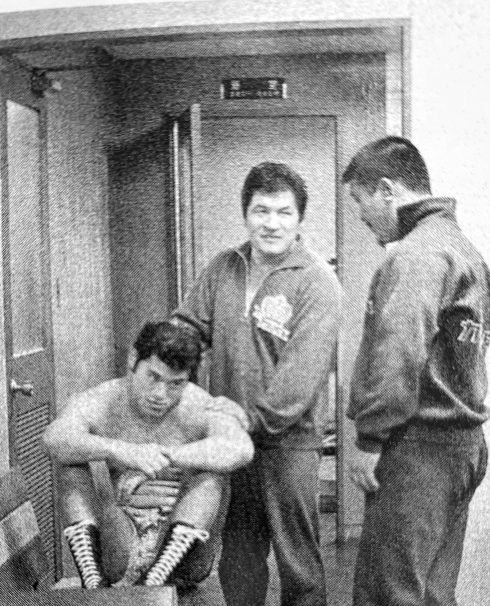
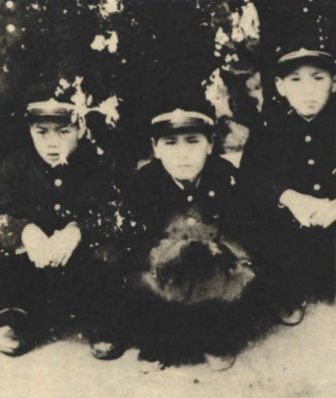

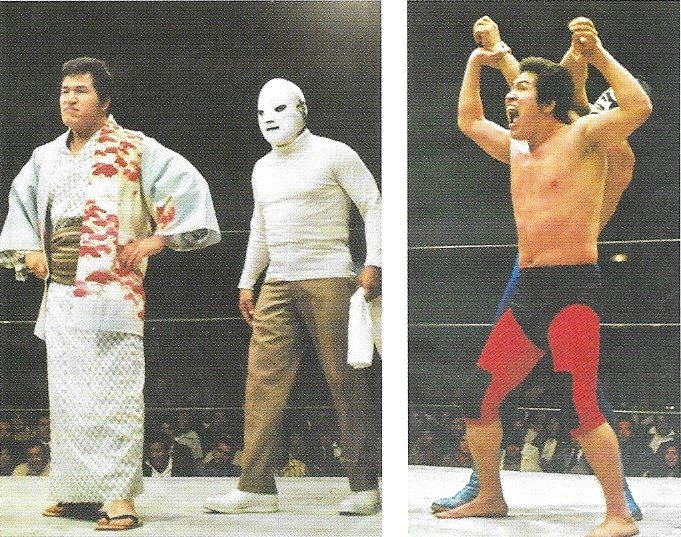
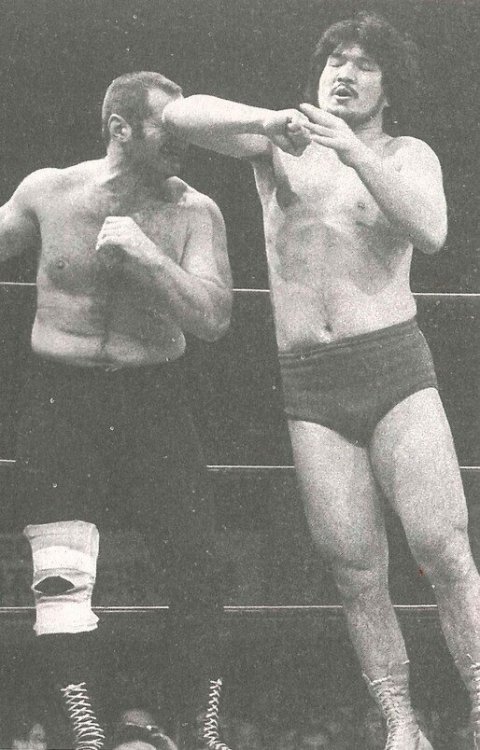
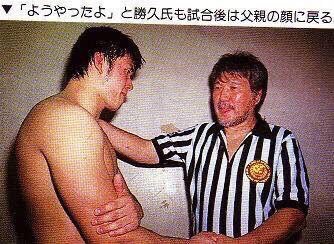
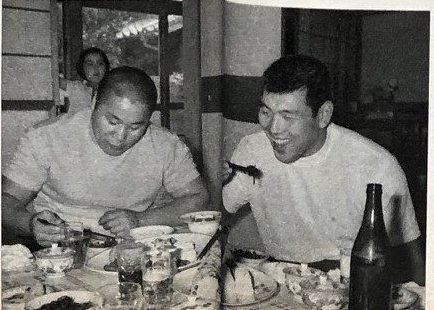
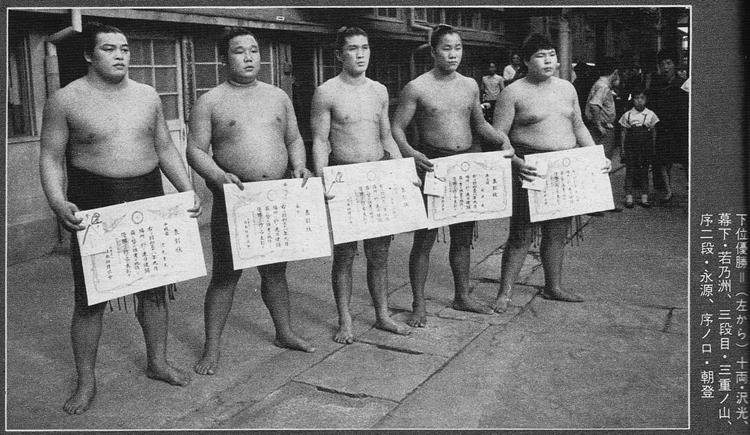
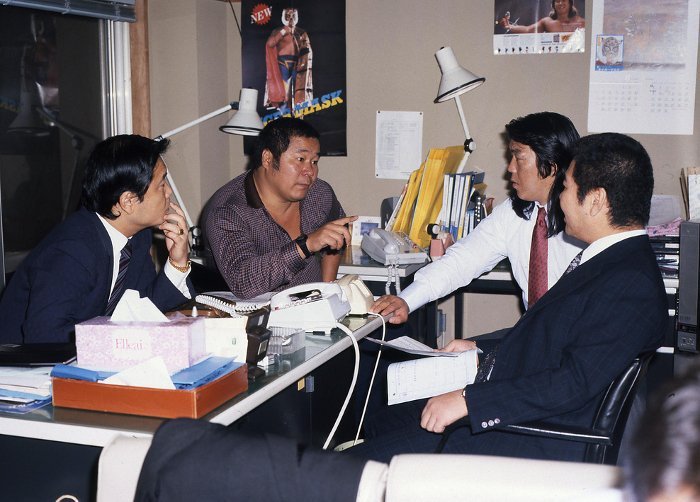
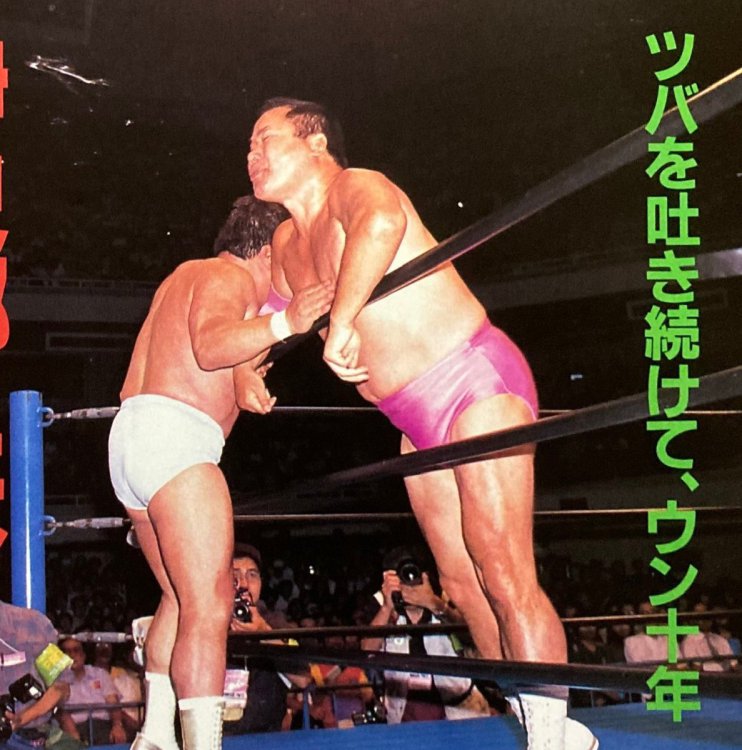
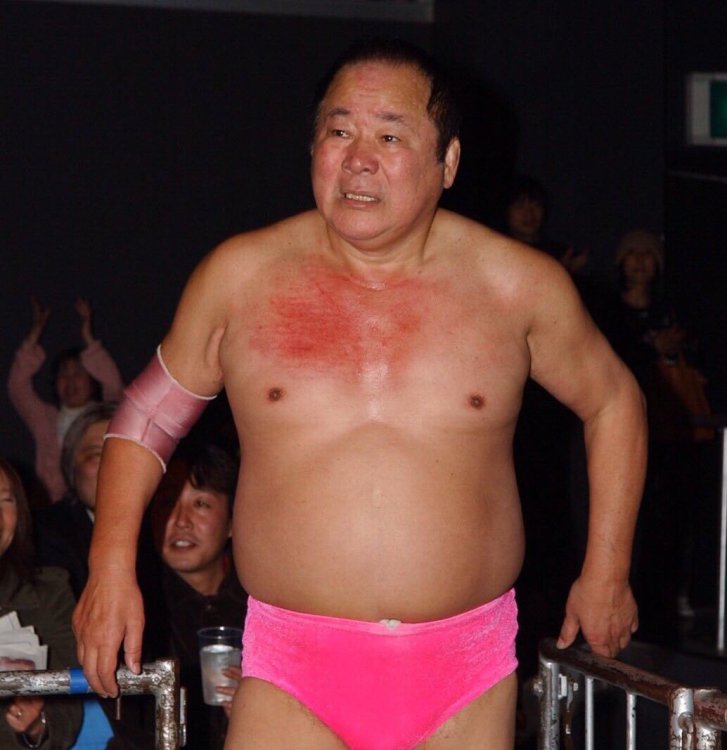
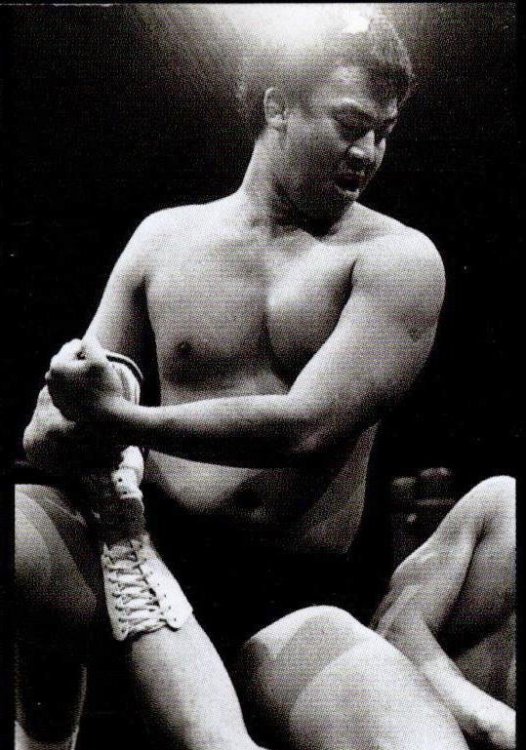
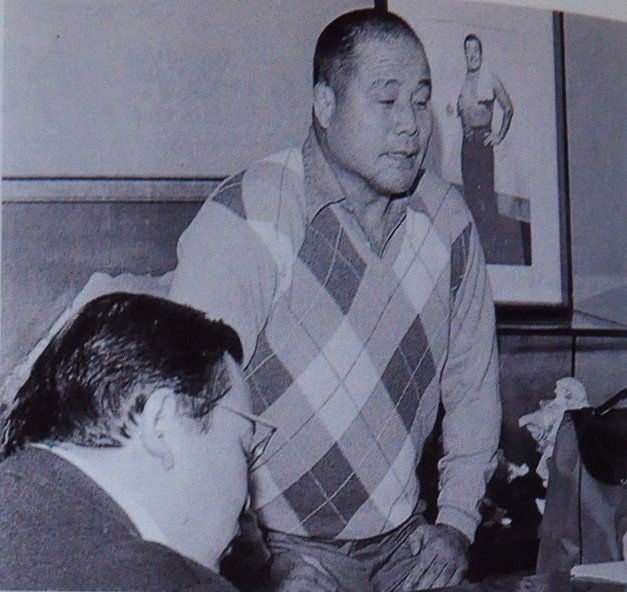
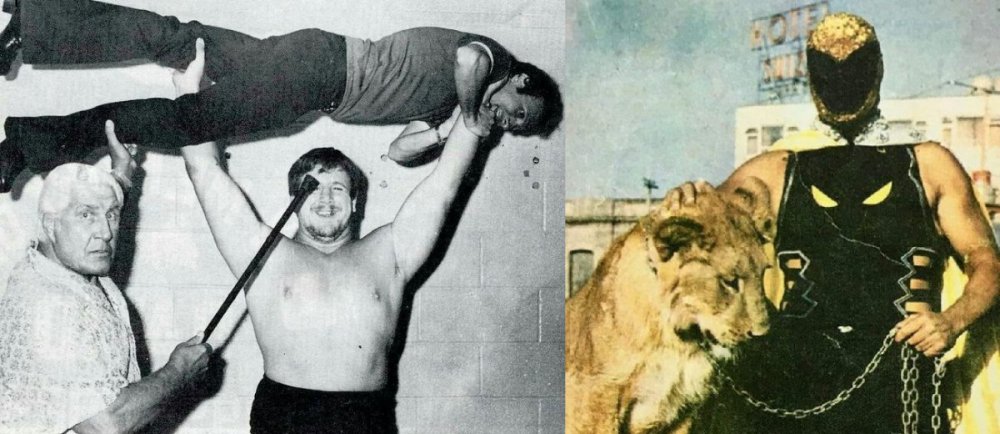
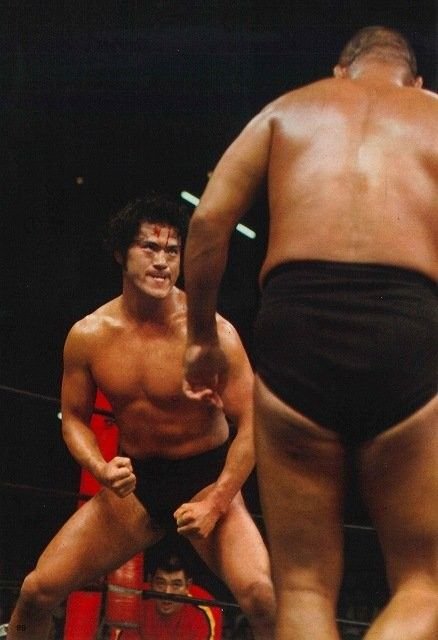
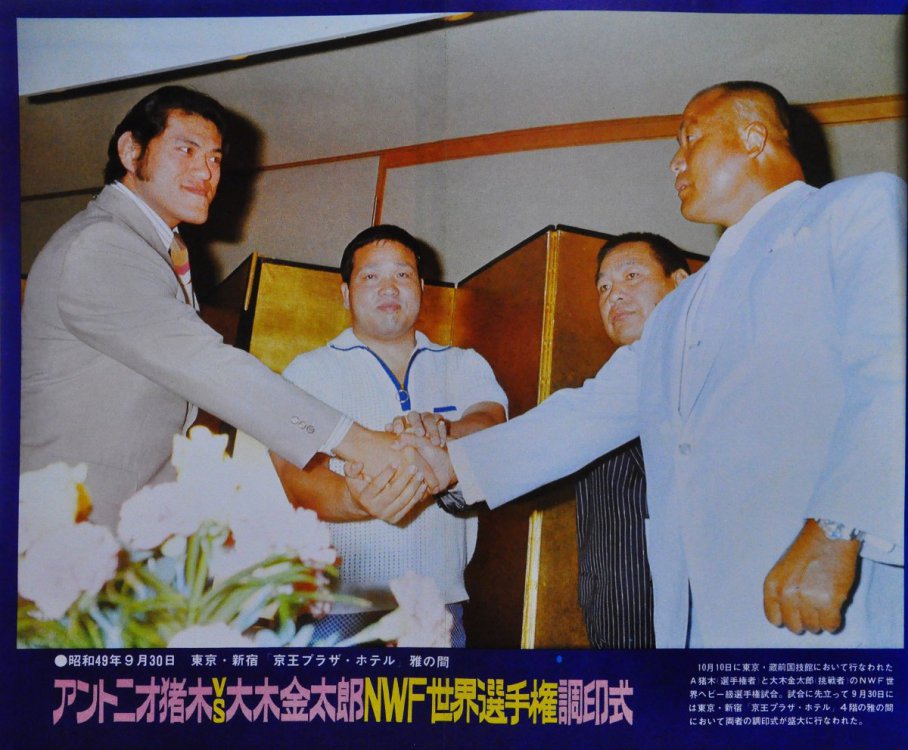
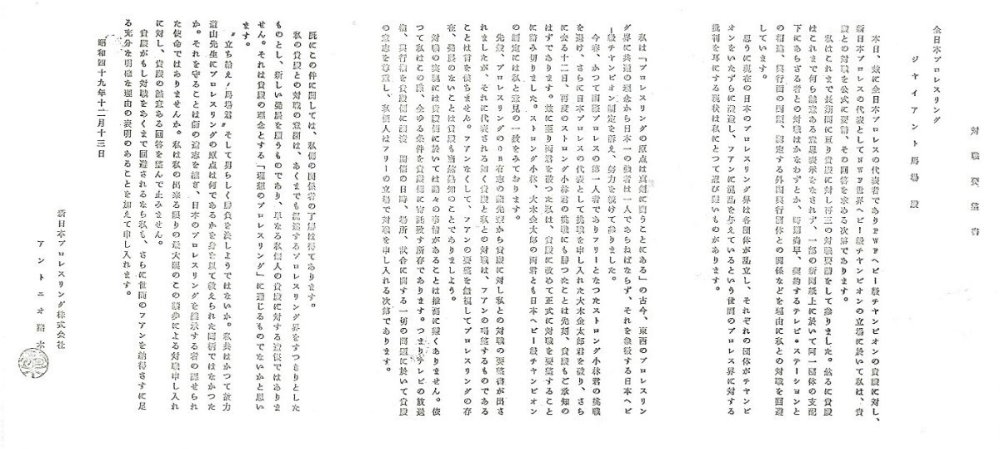

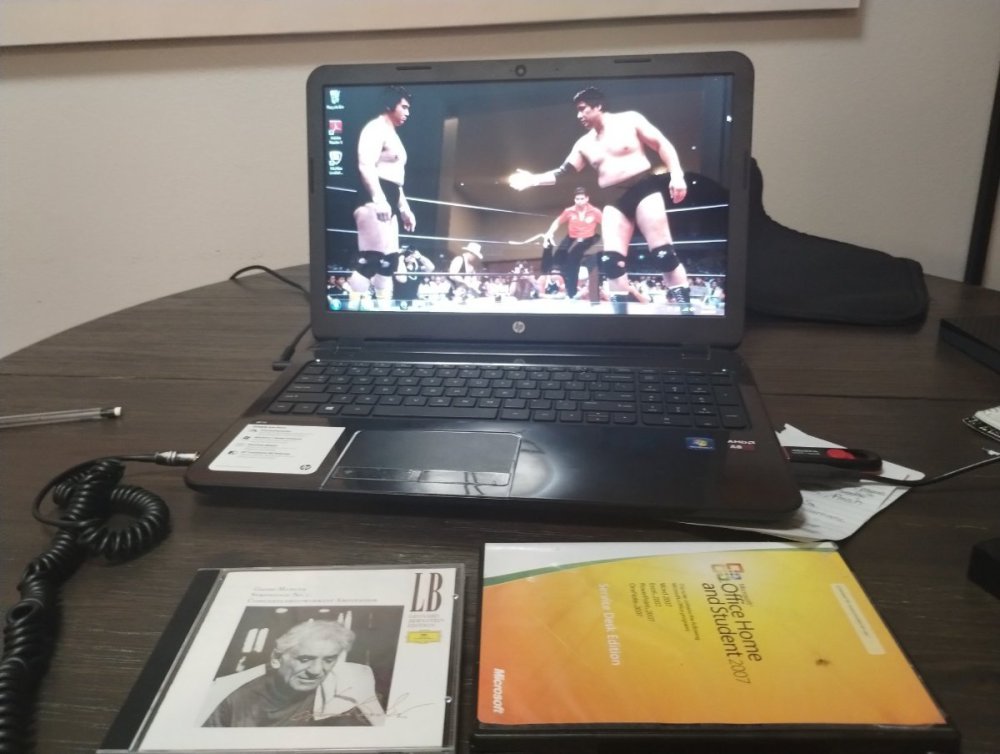
.png.a9af202f230e6105255bfa246c143670.png)
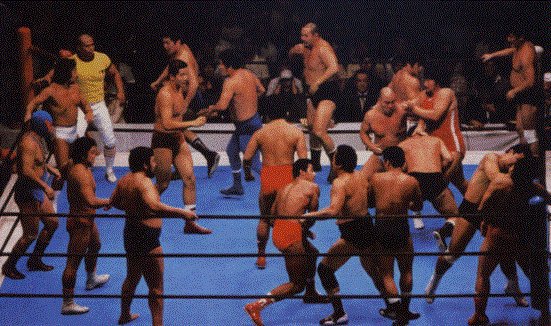
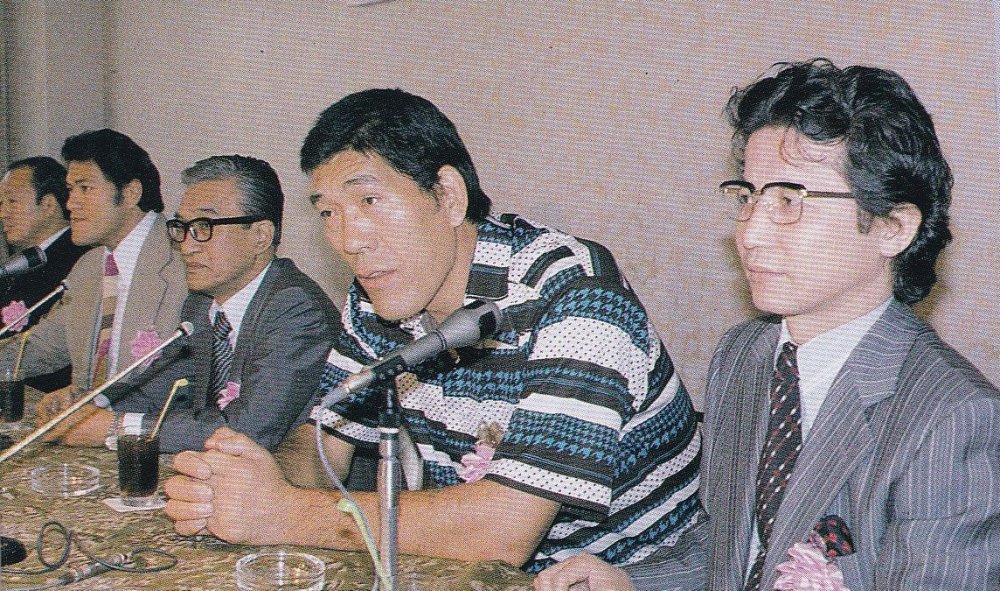
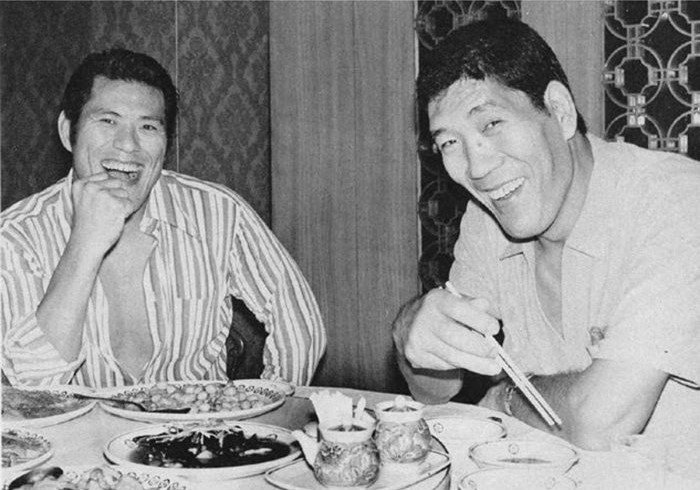
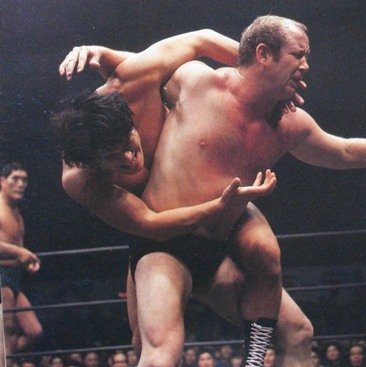
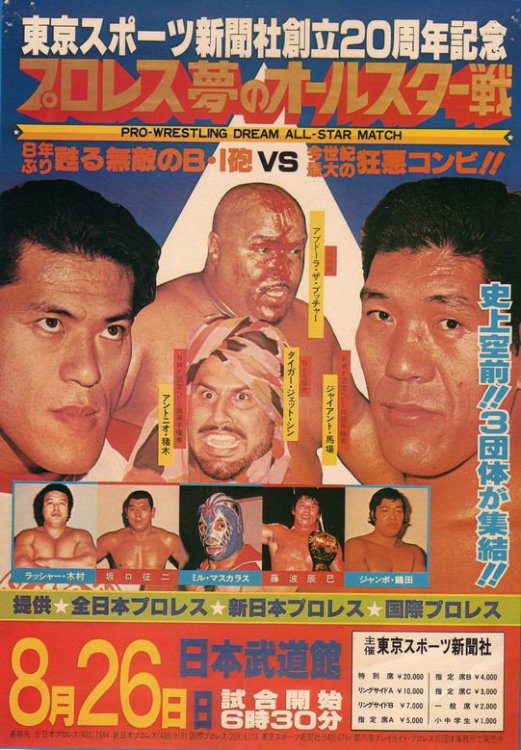
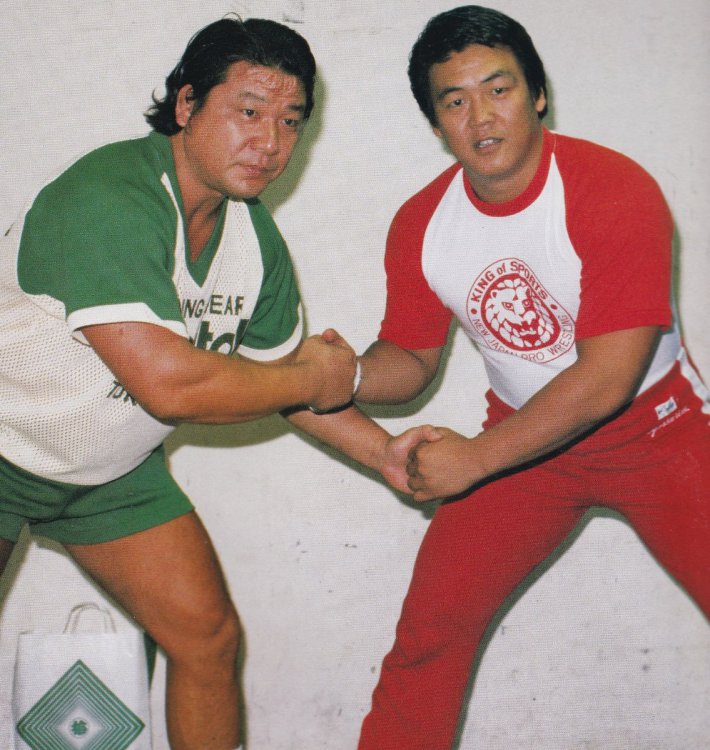
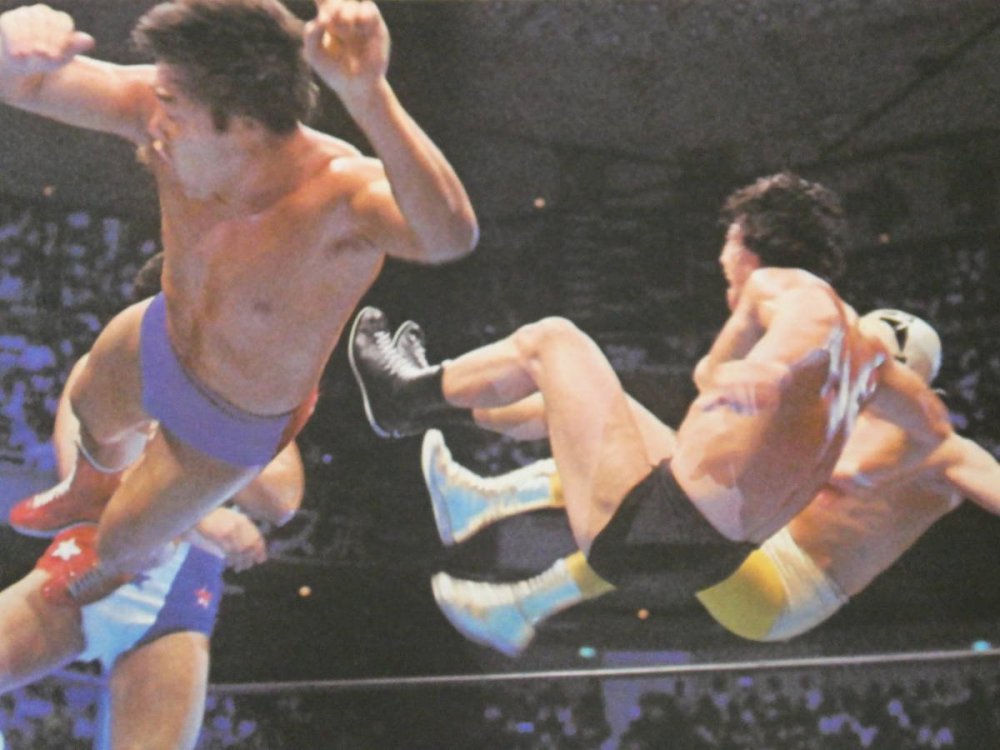
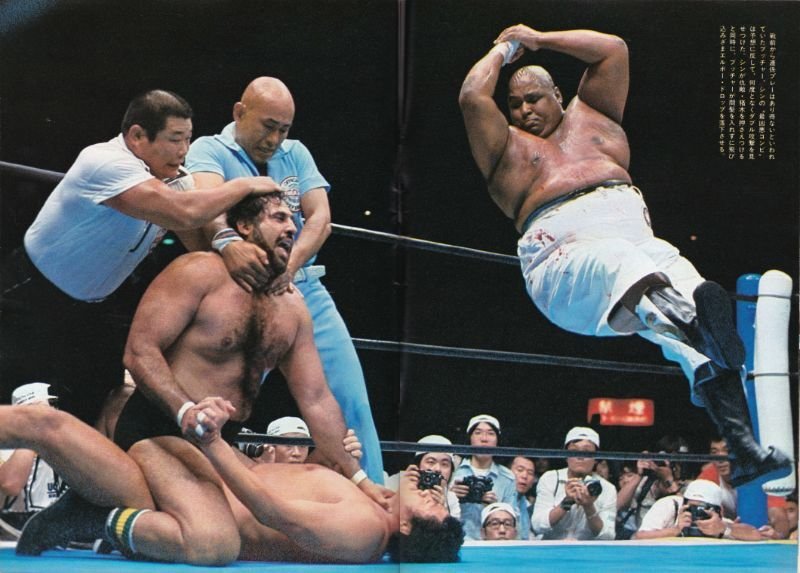
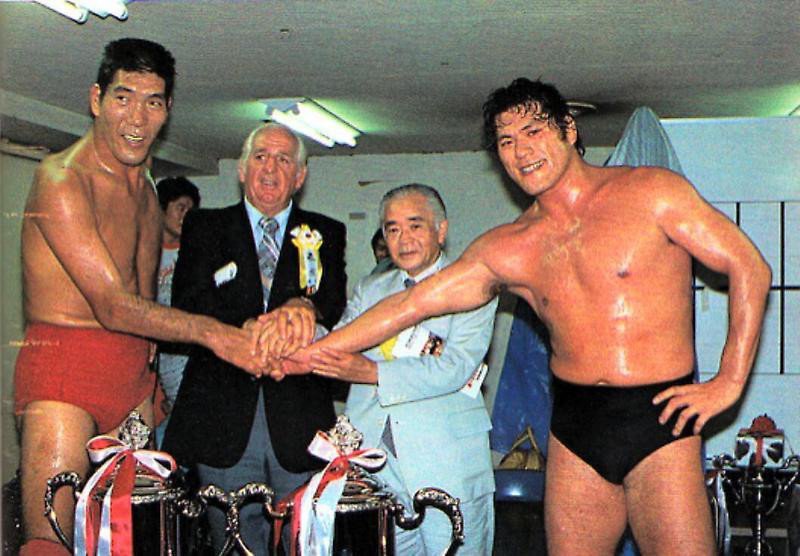

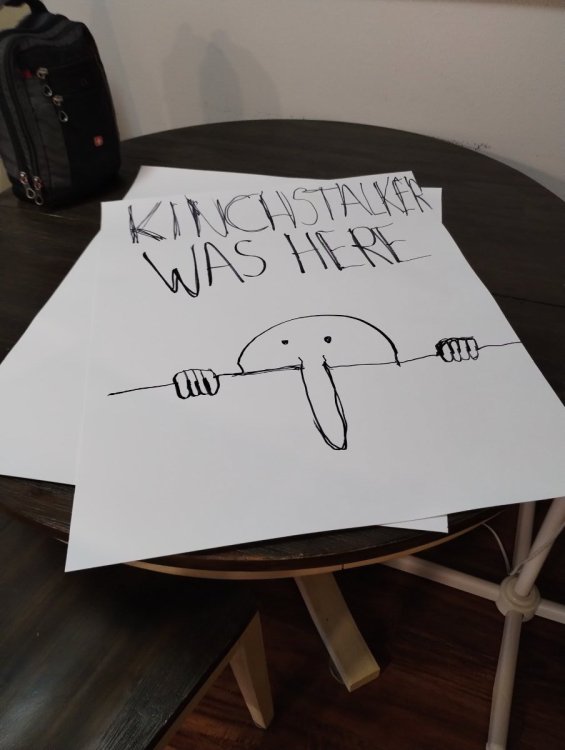
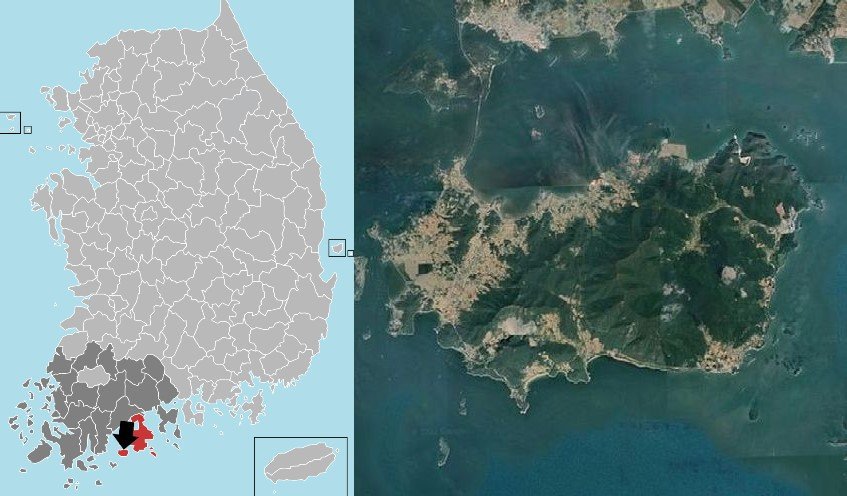
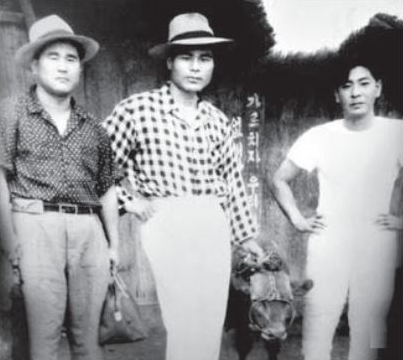
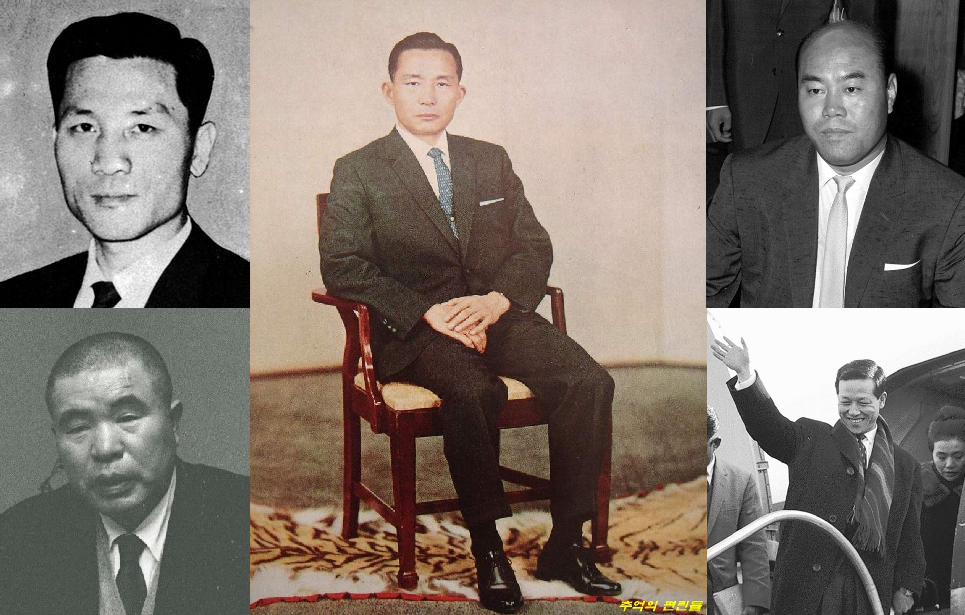
.jpg.a70ebae1012a3e97dbf58532c8ba2b9f.jpg)
